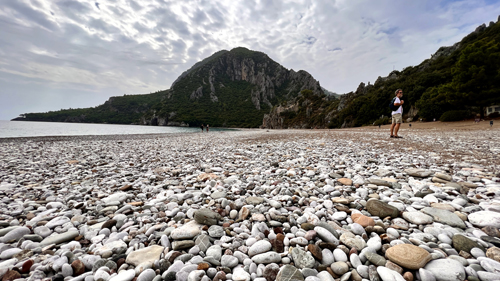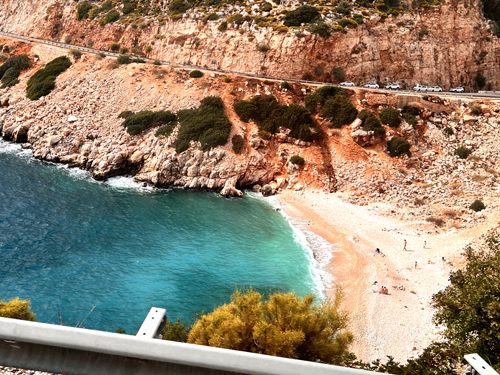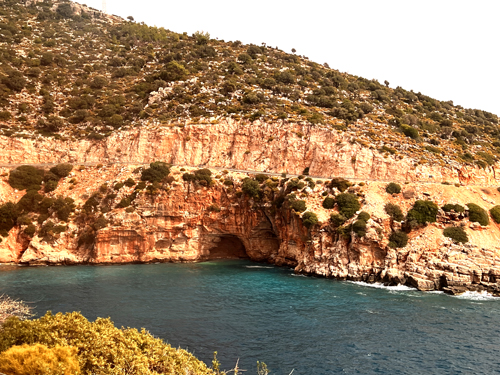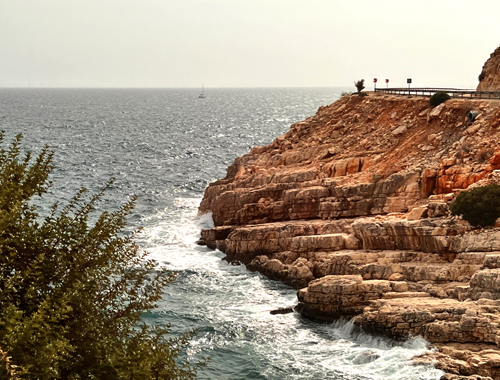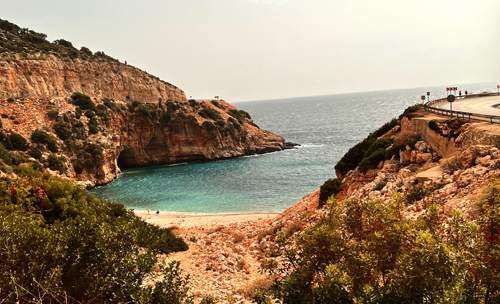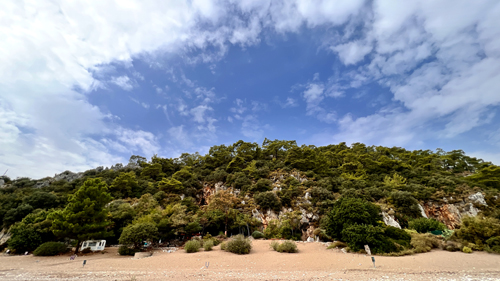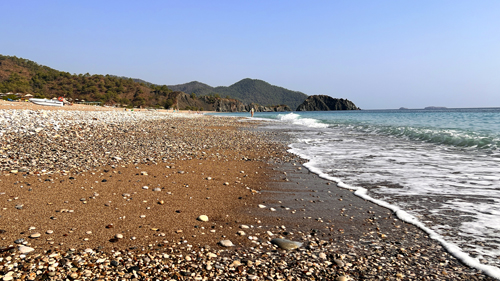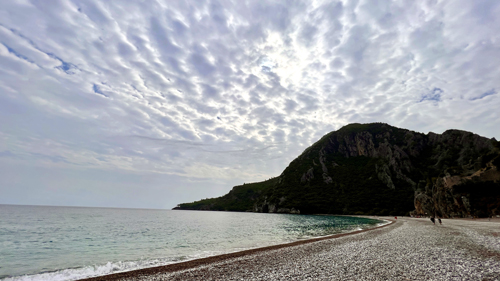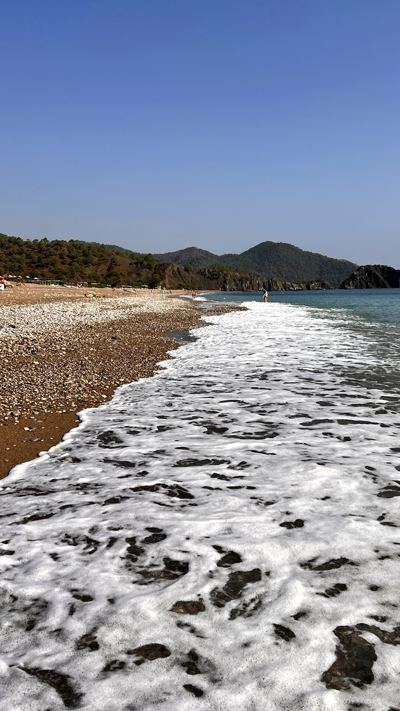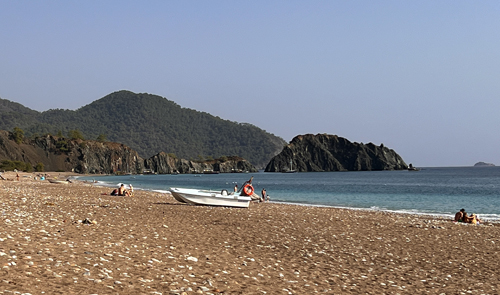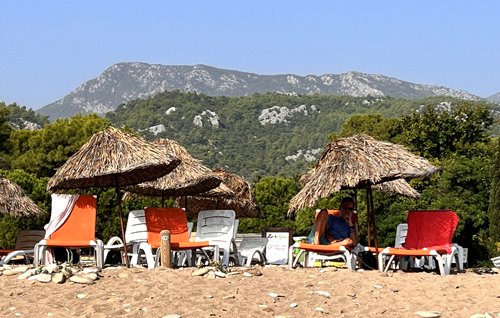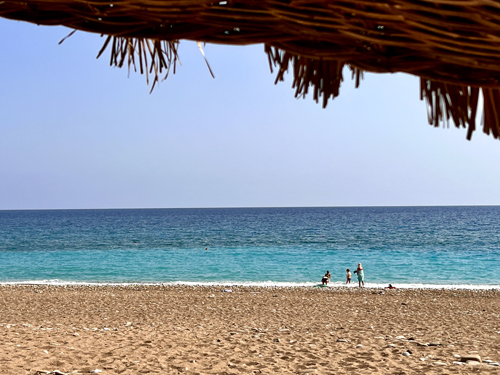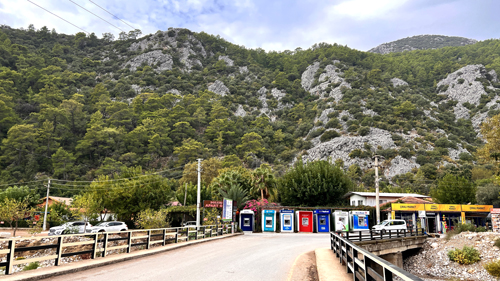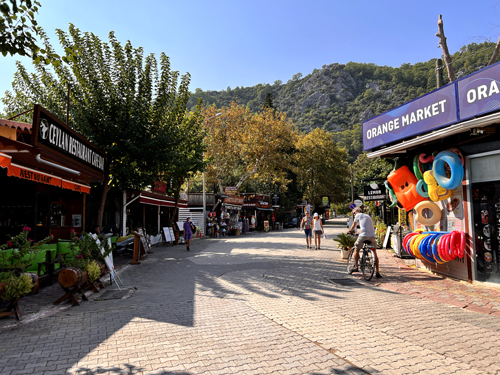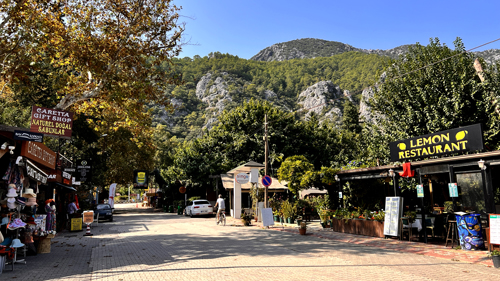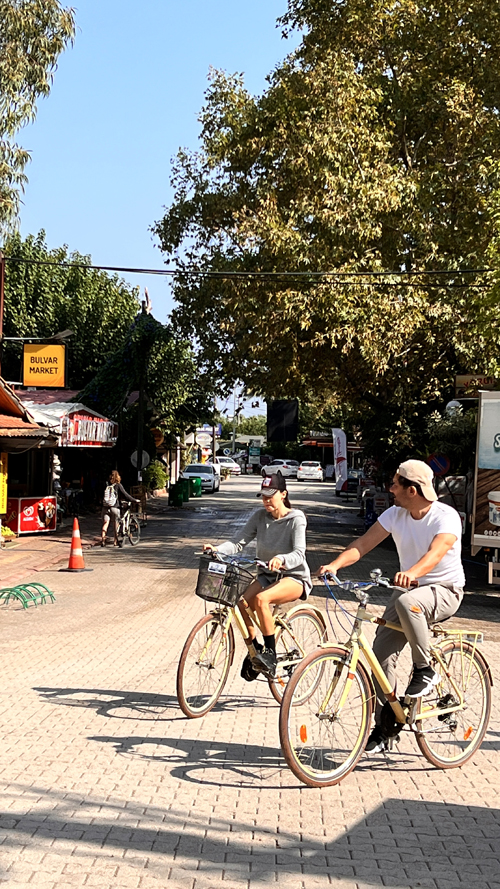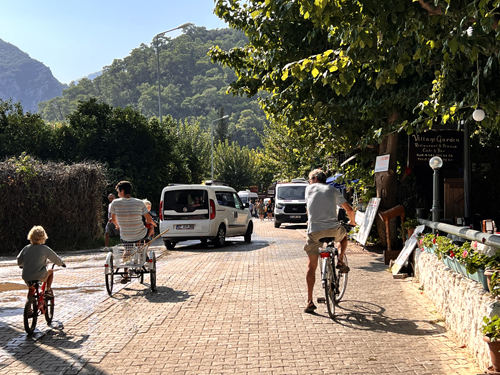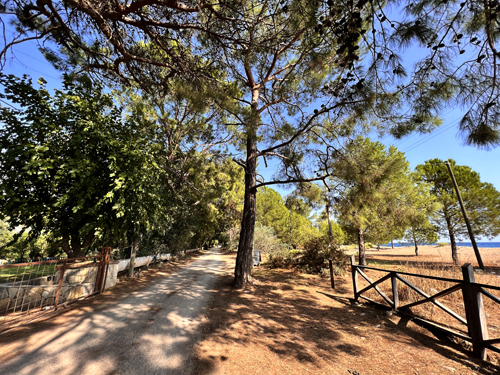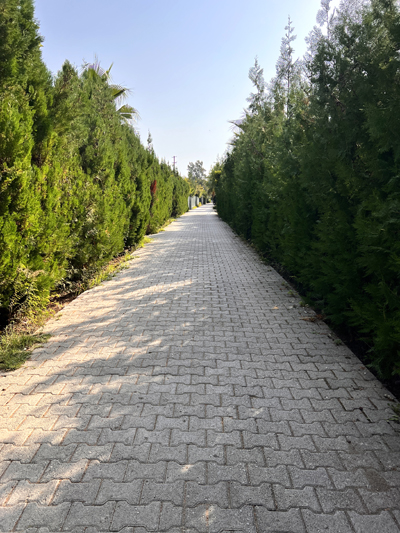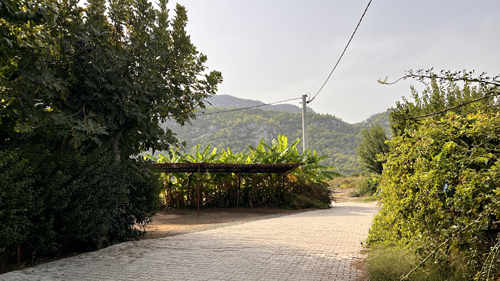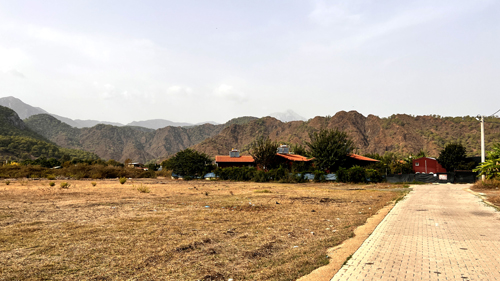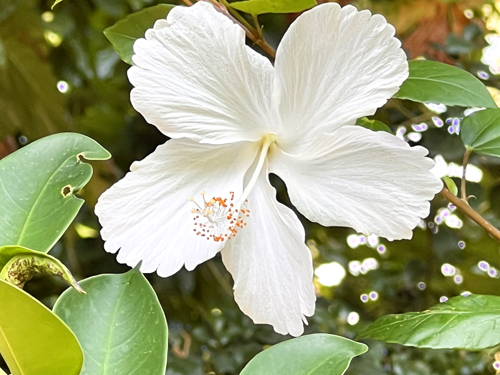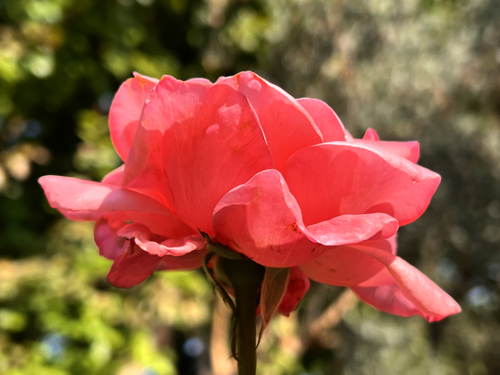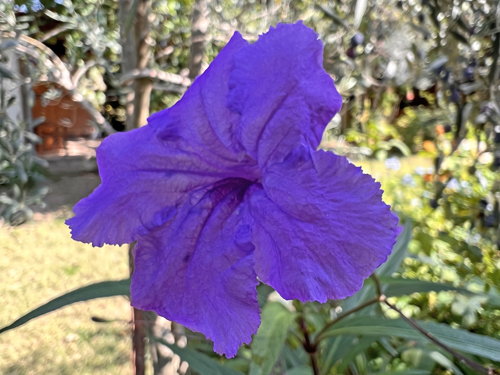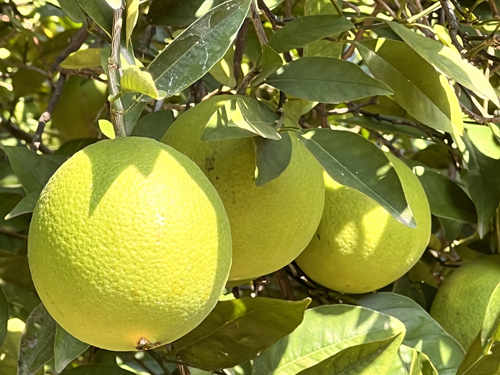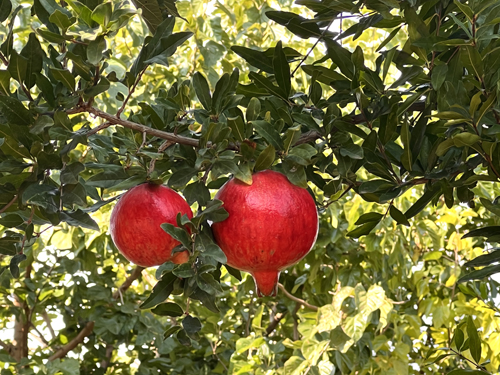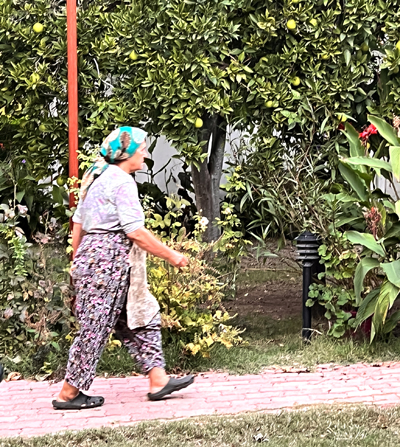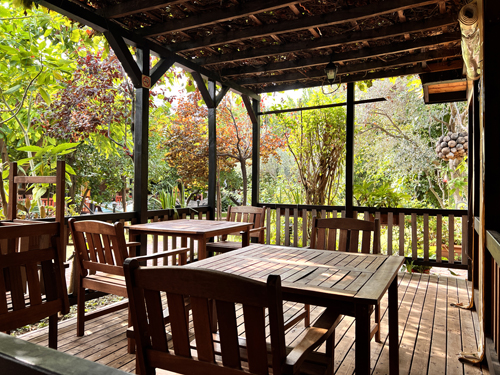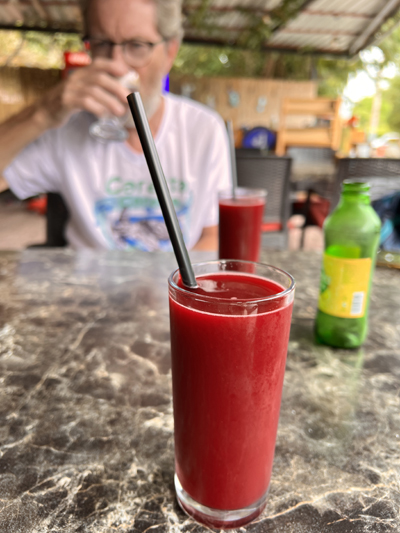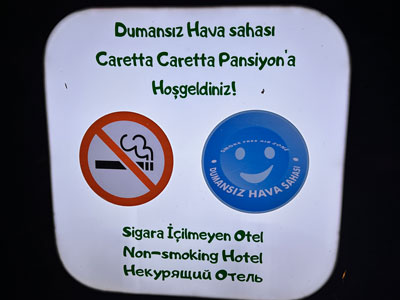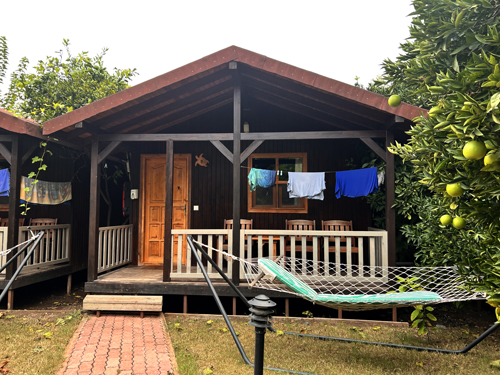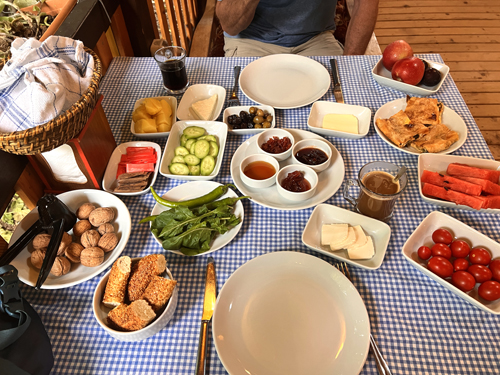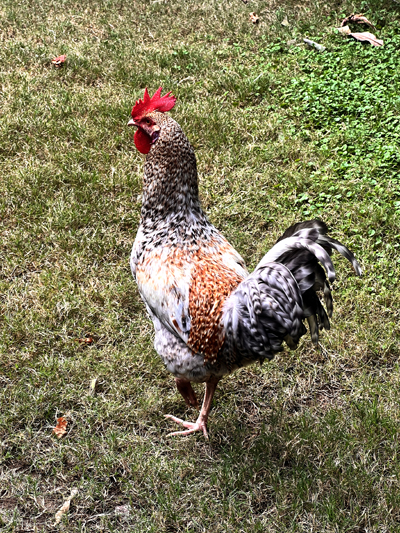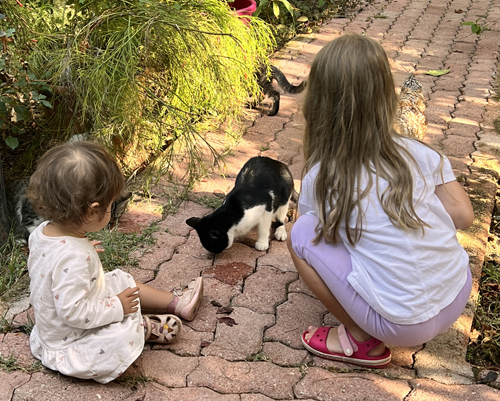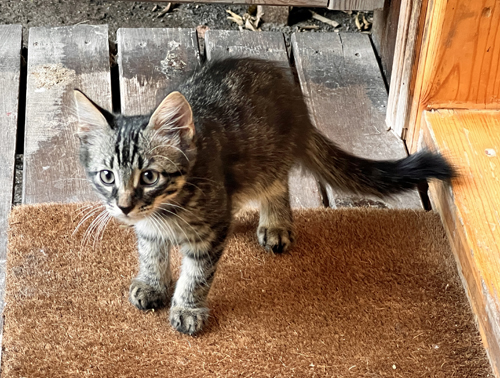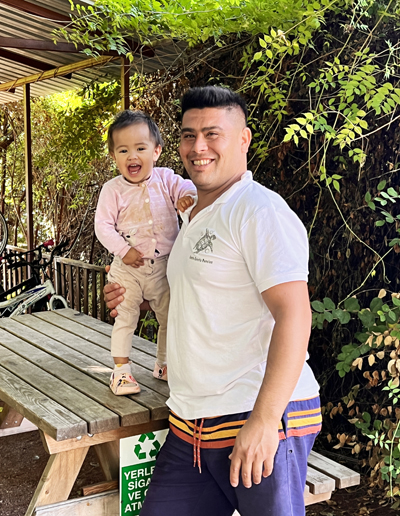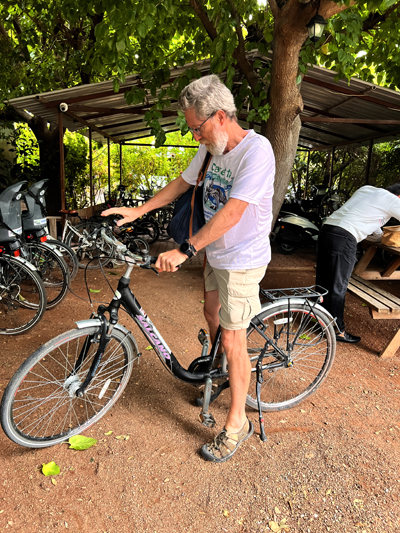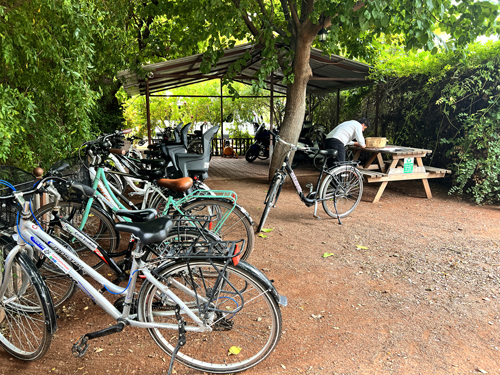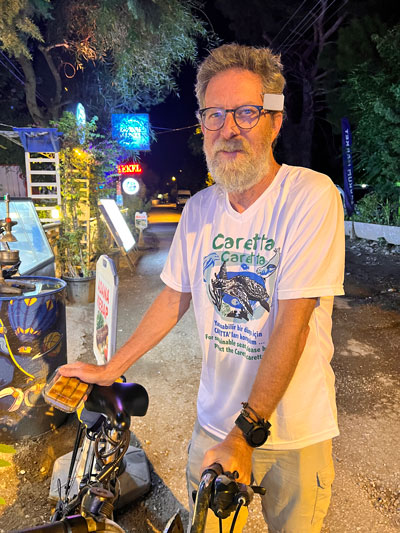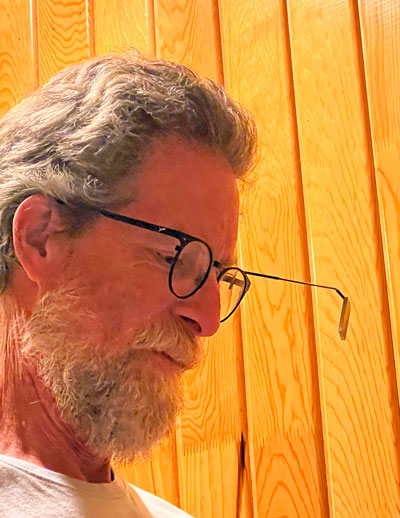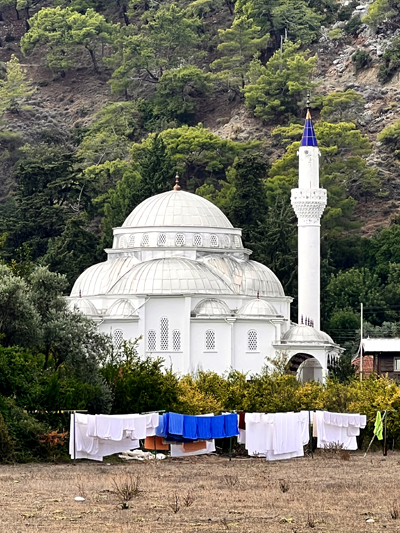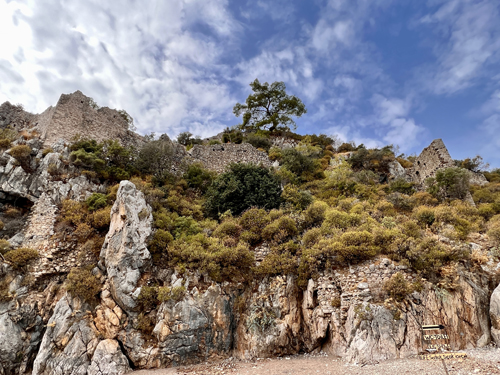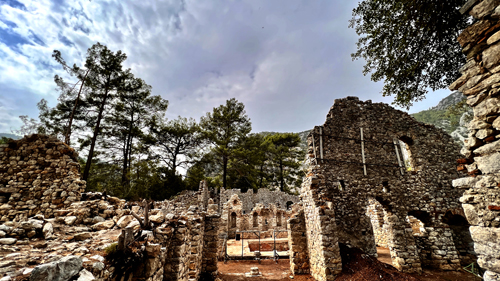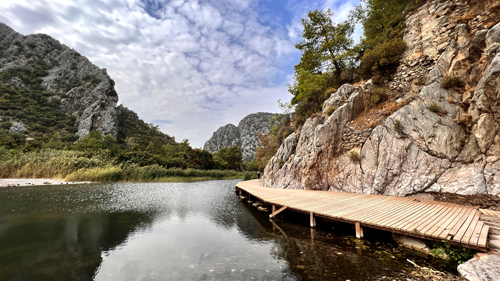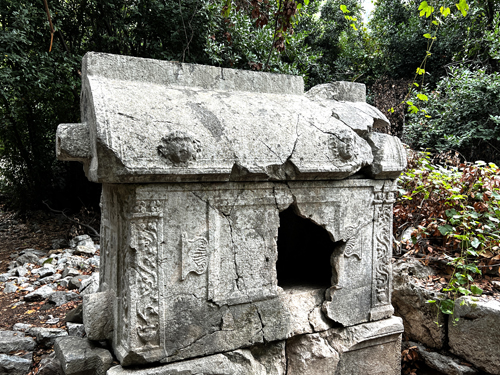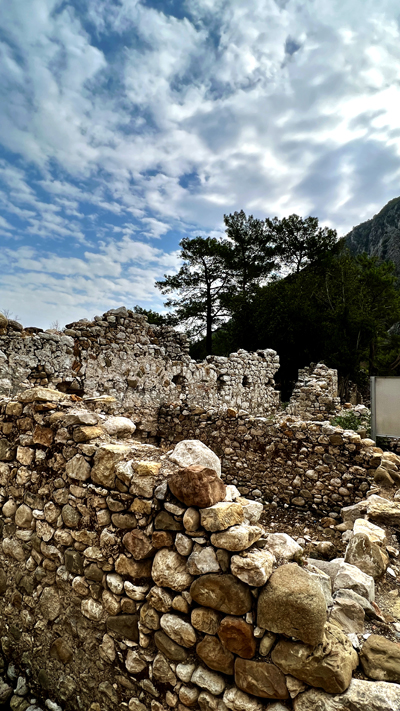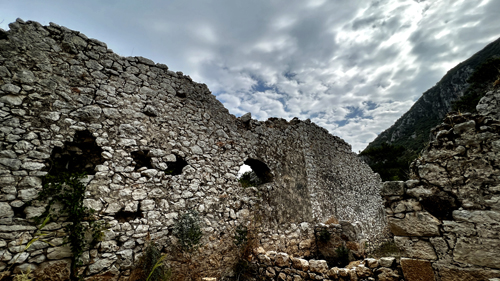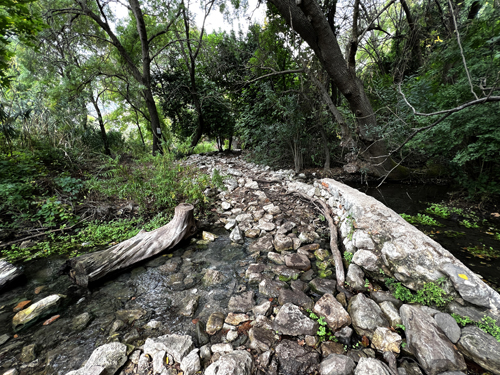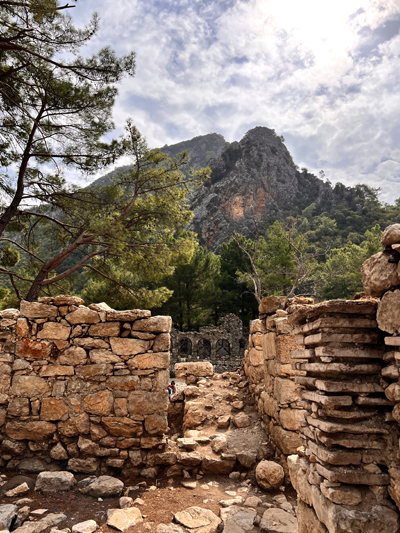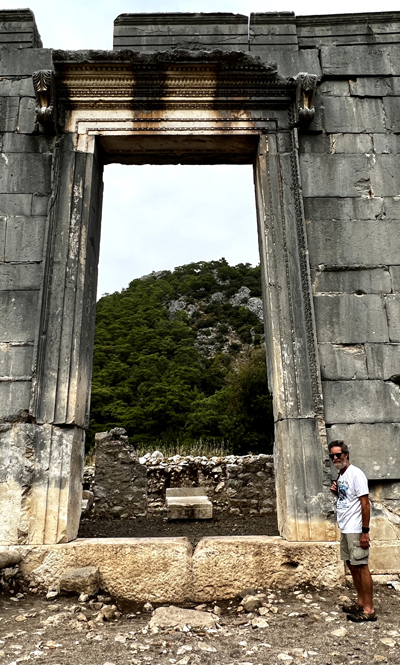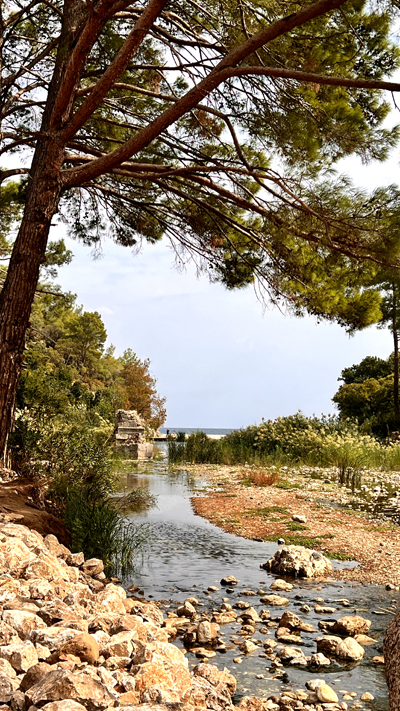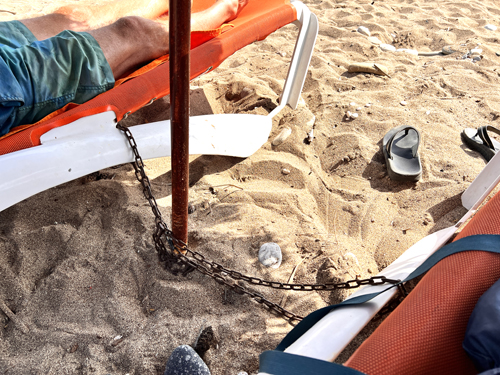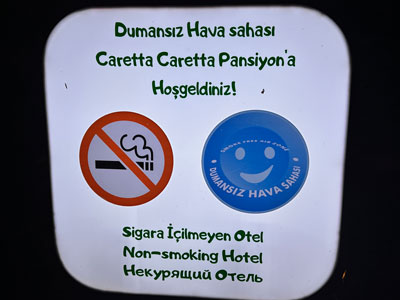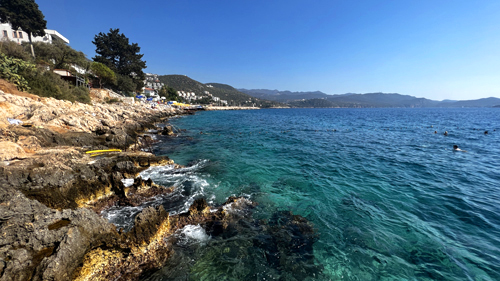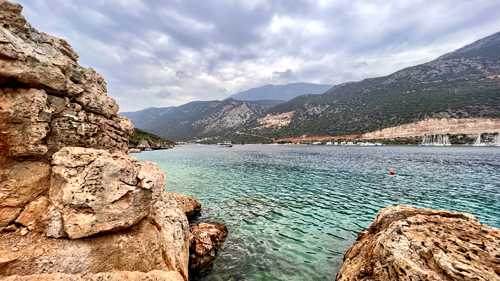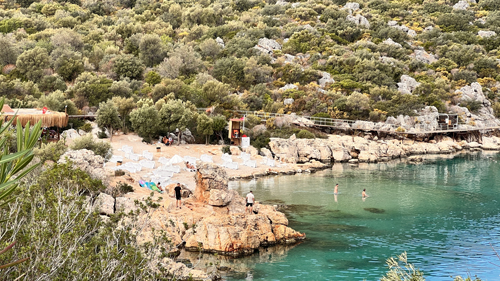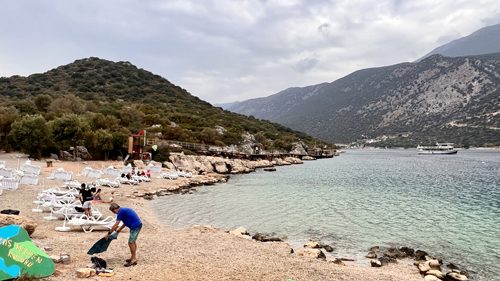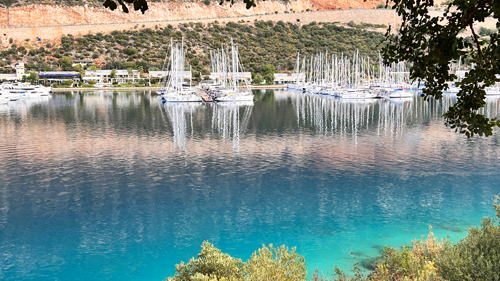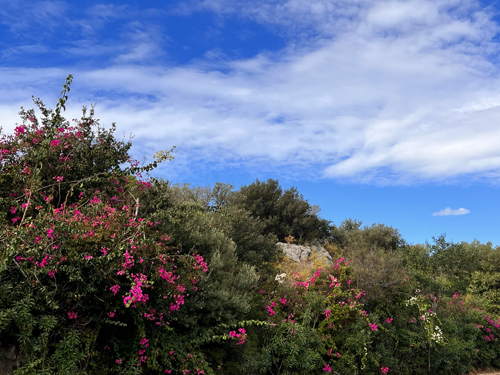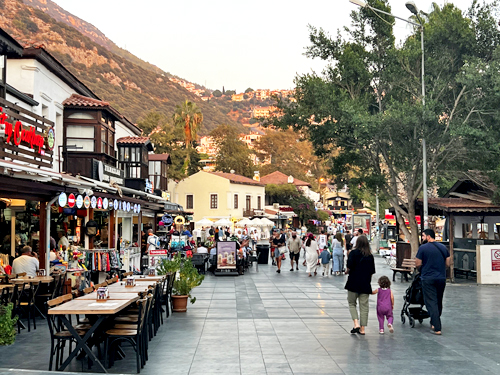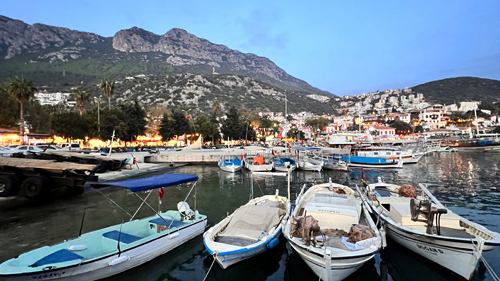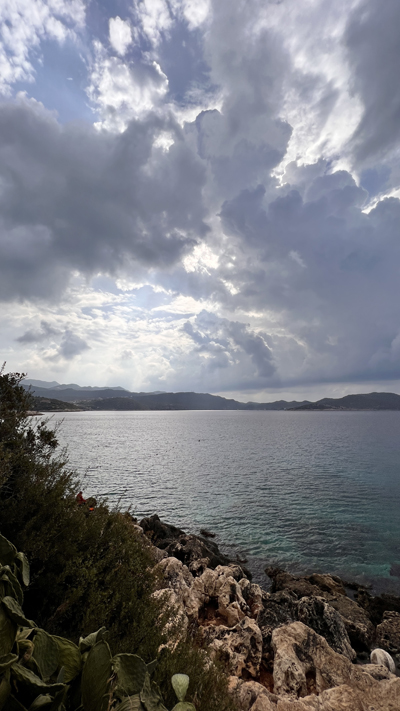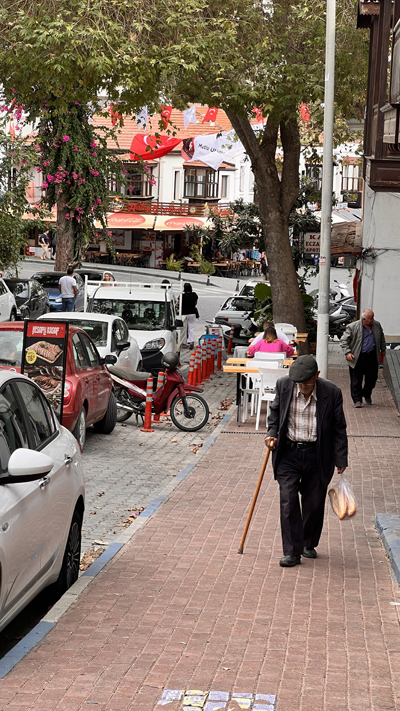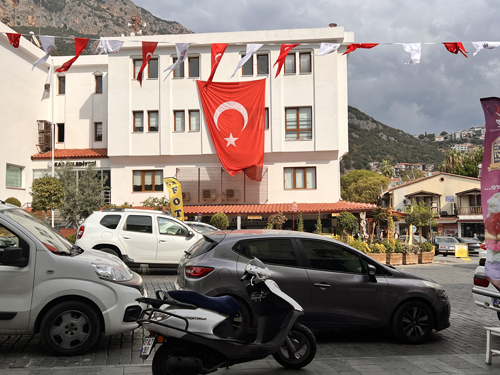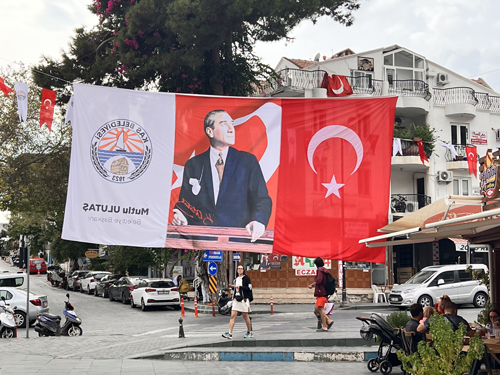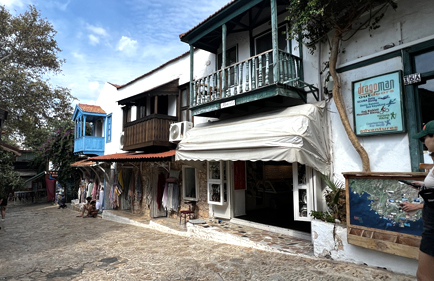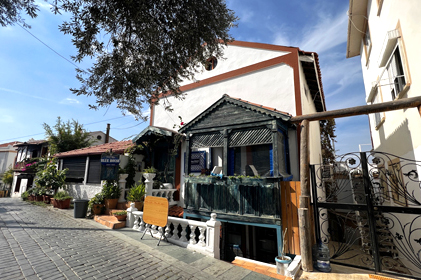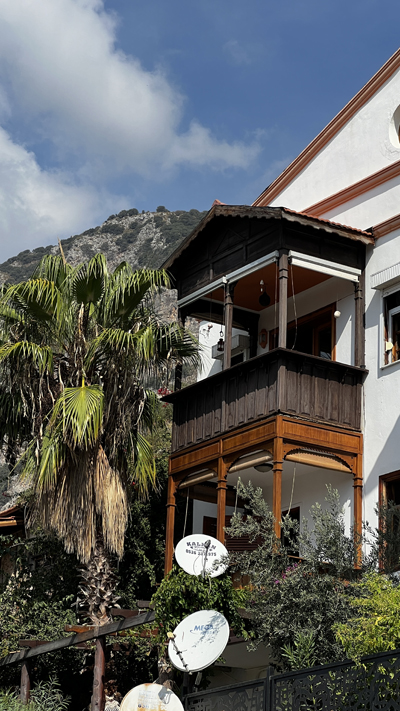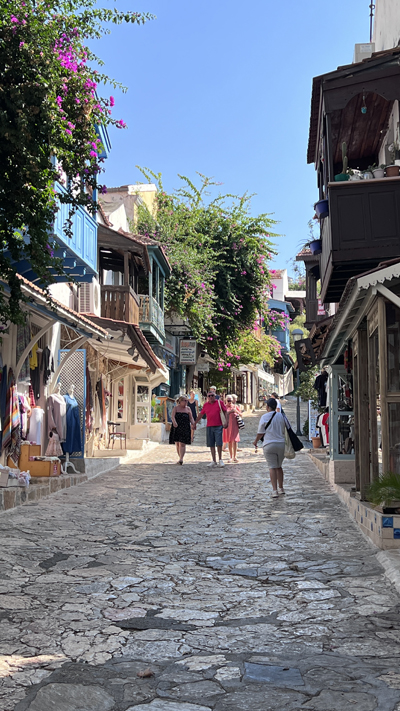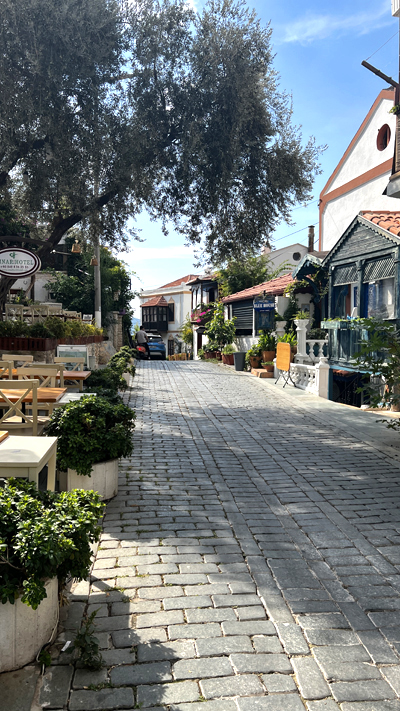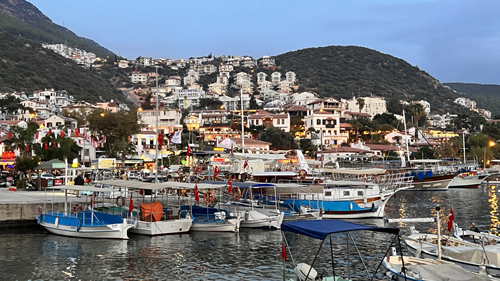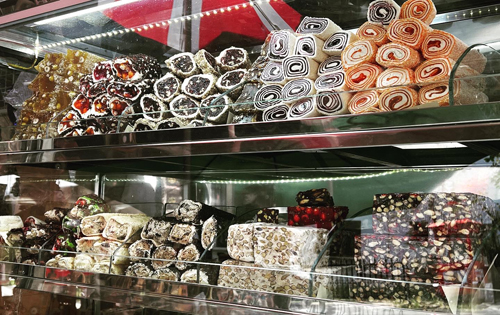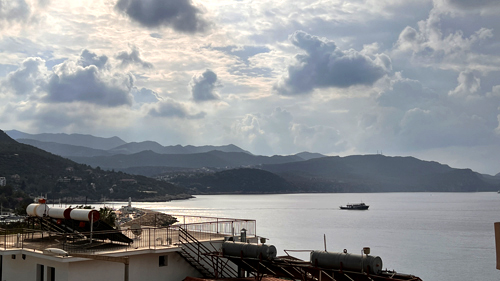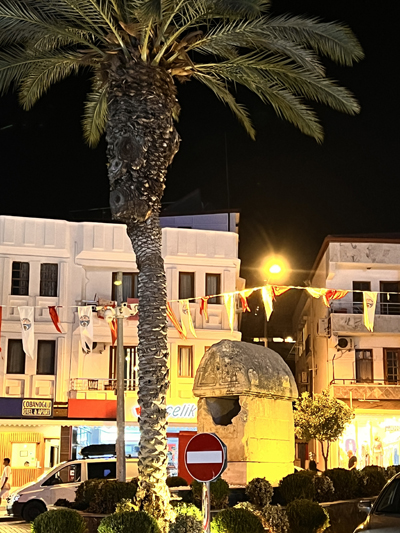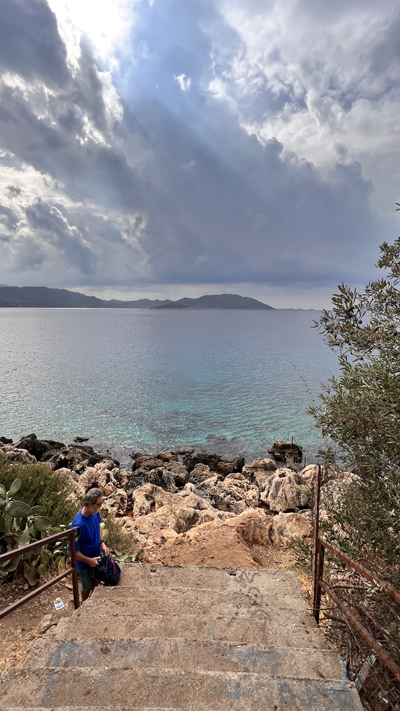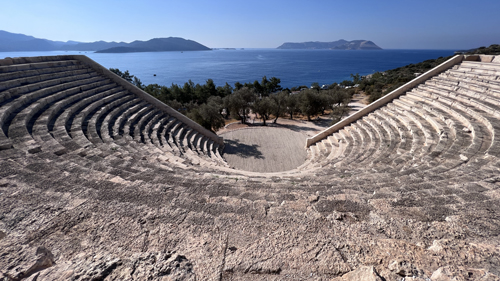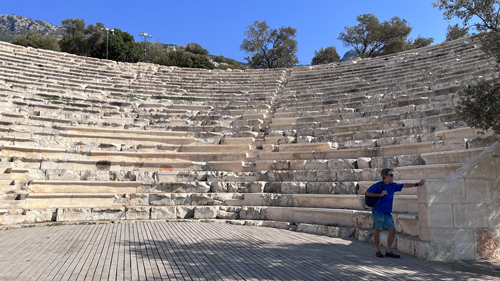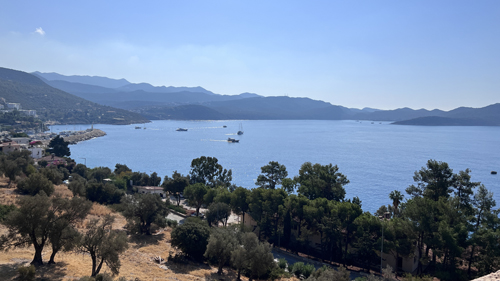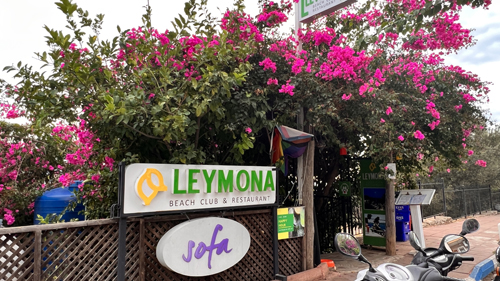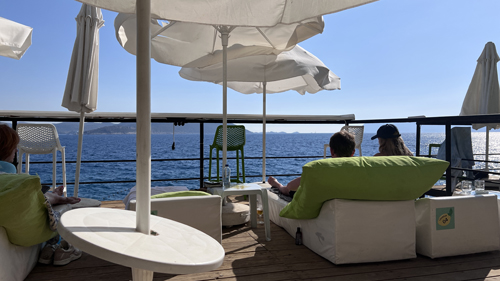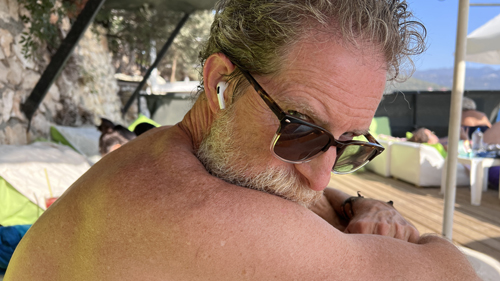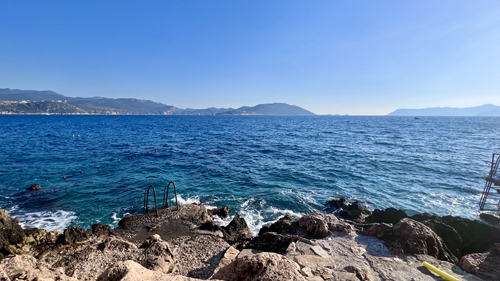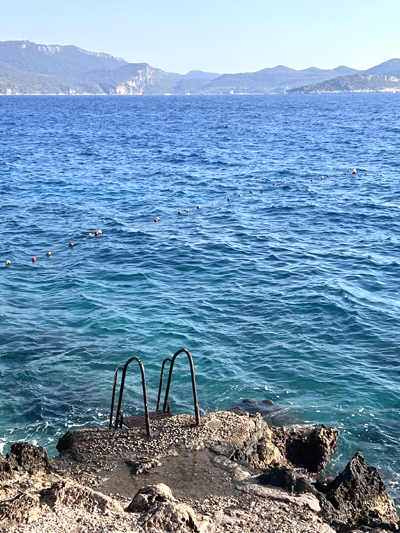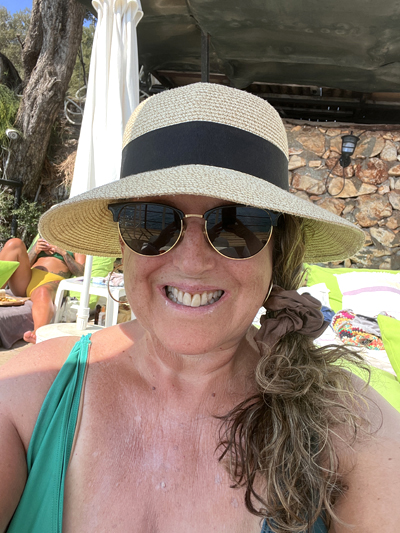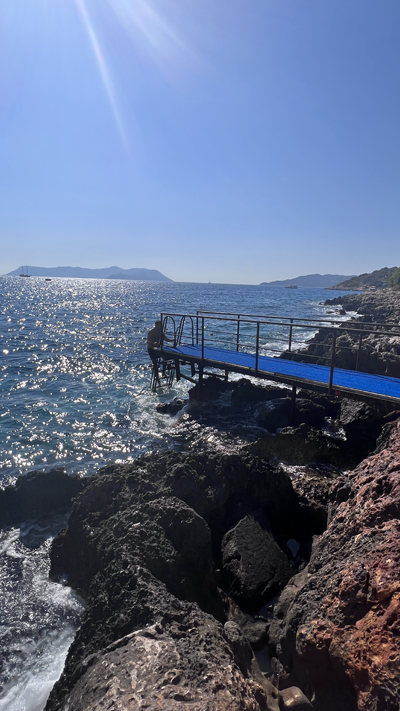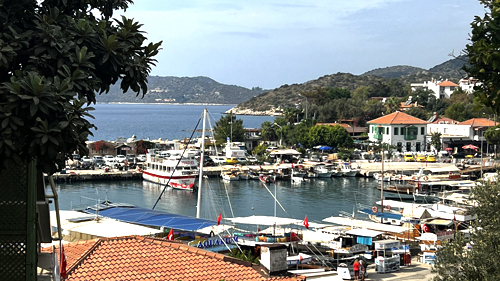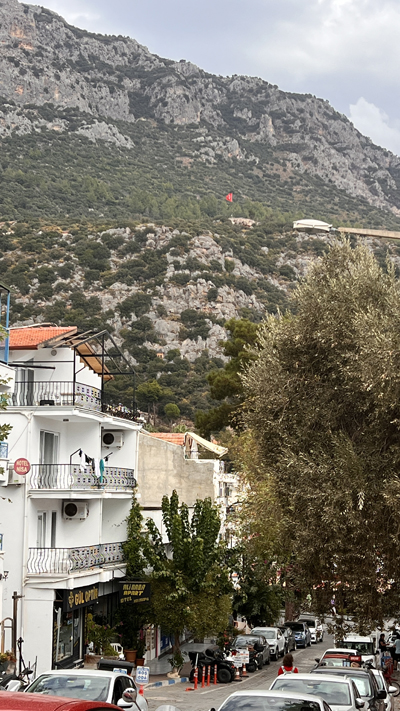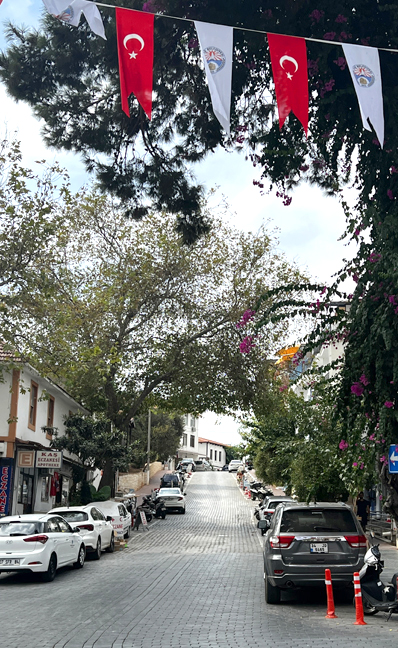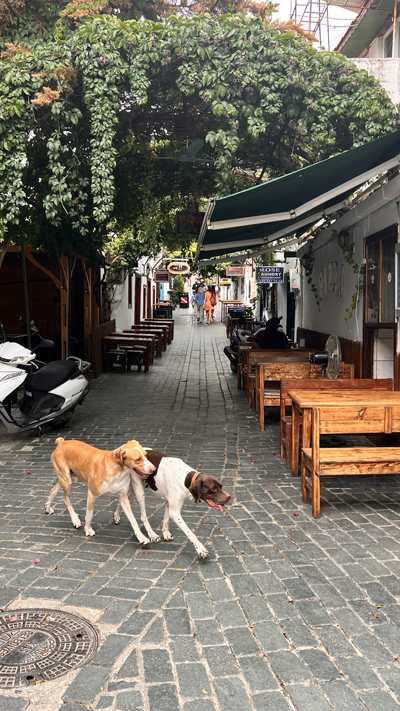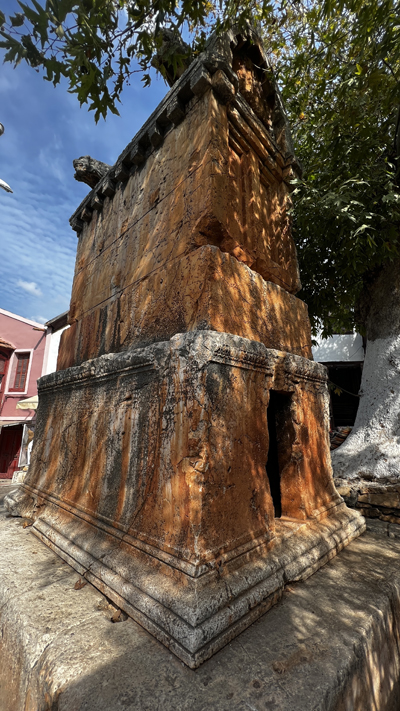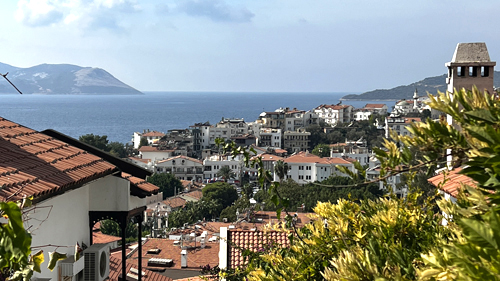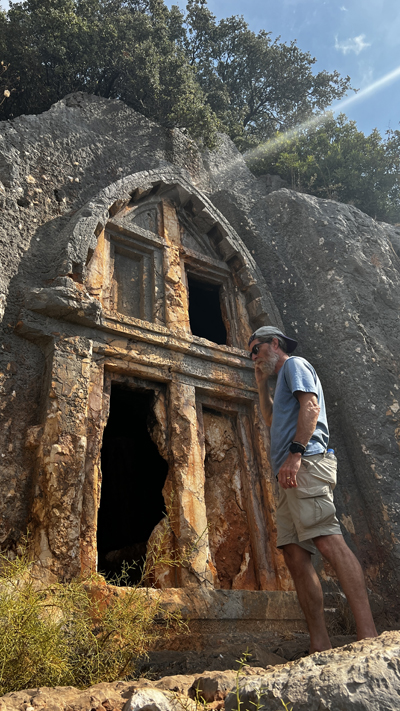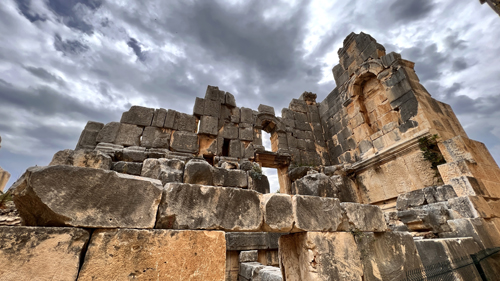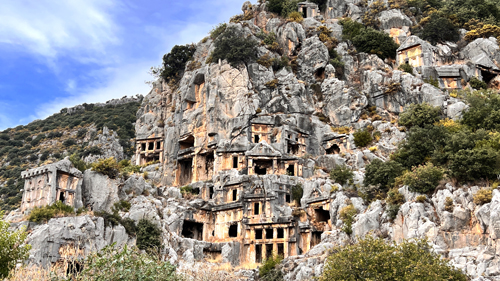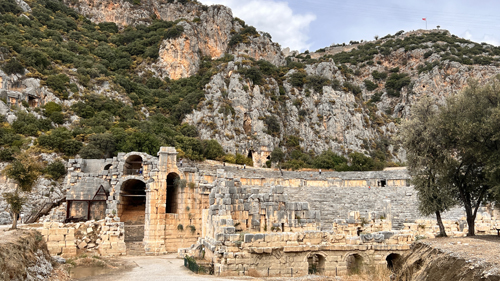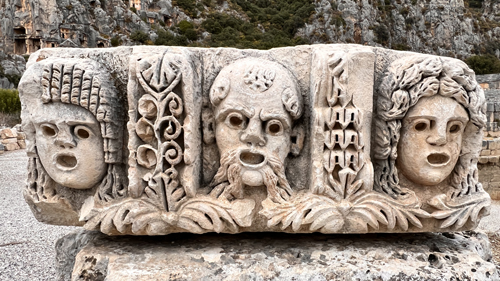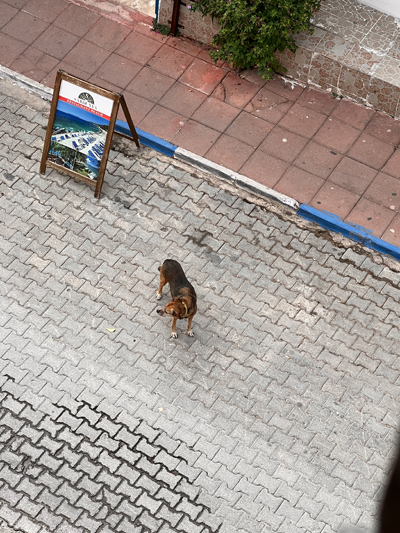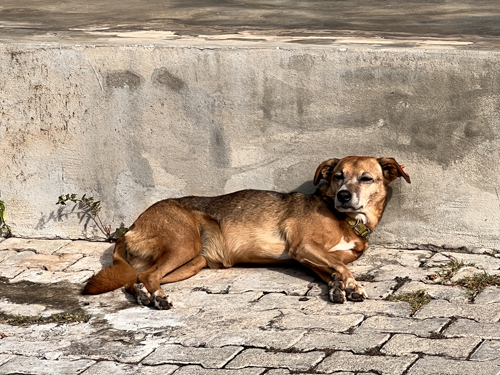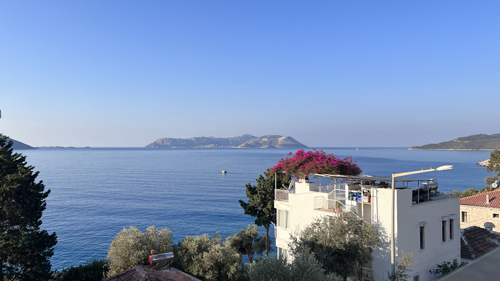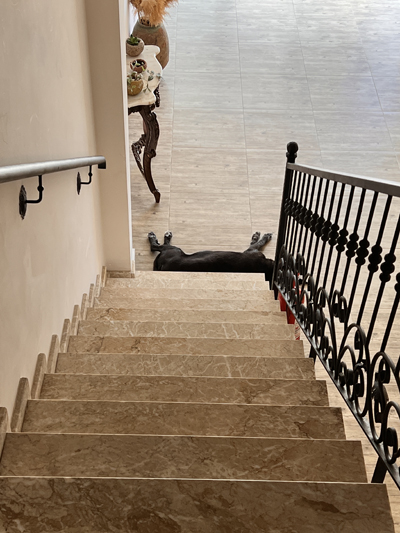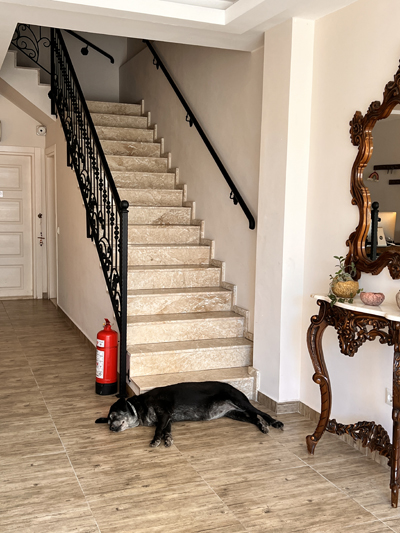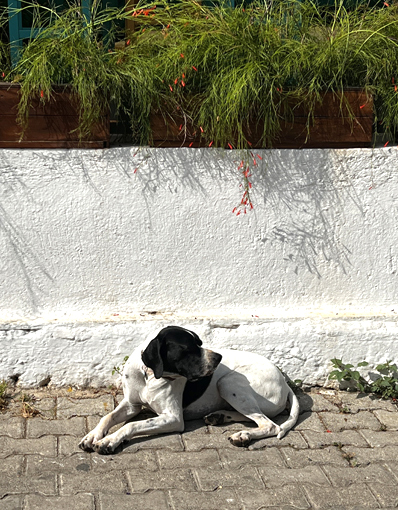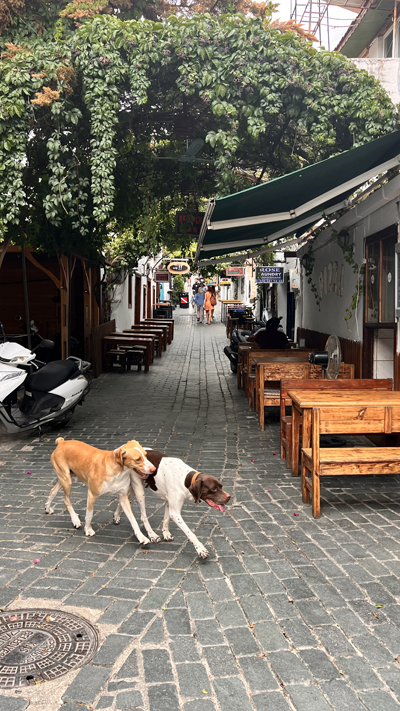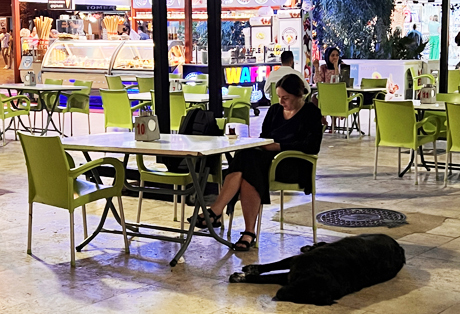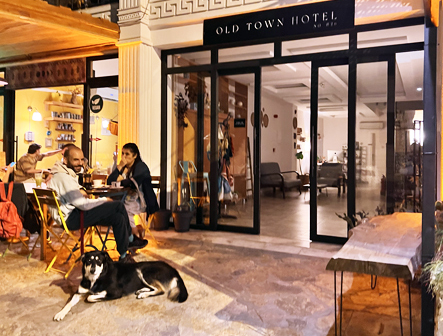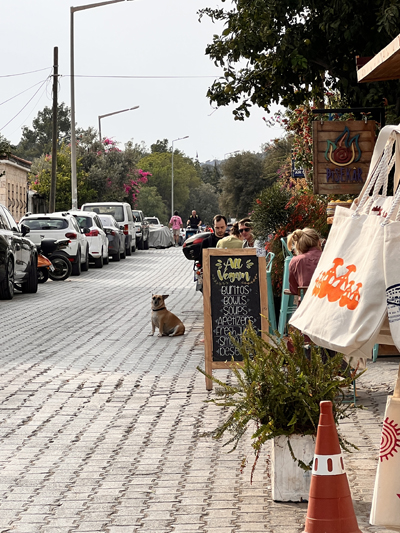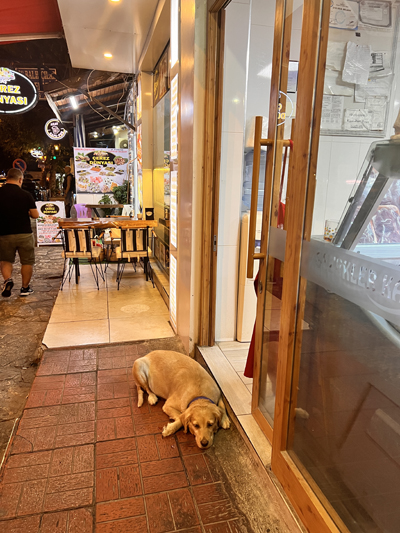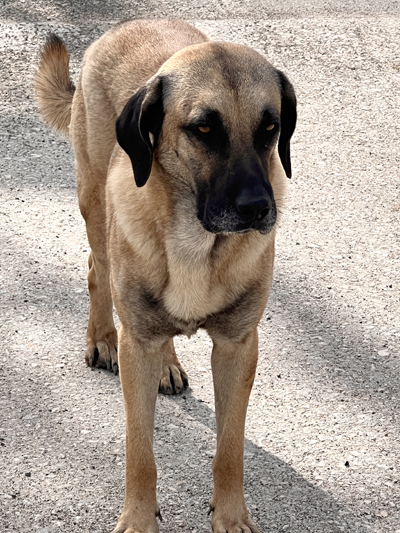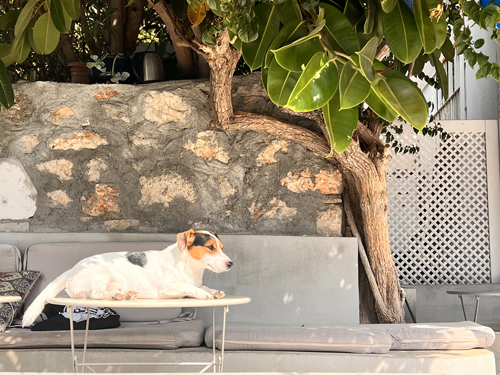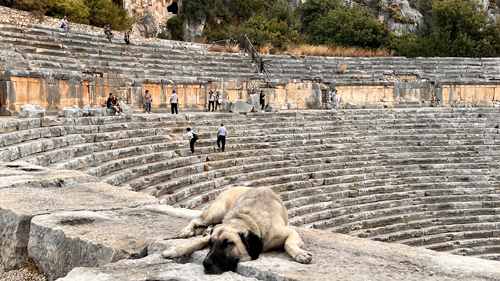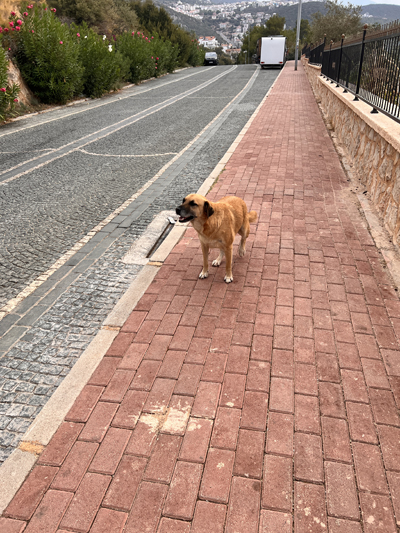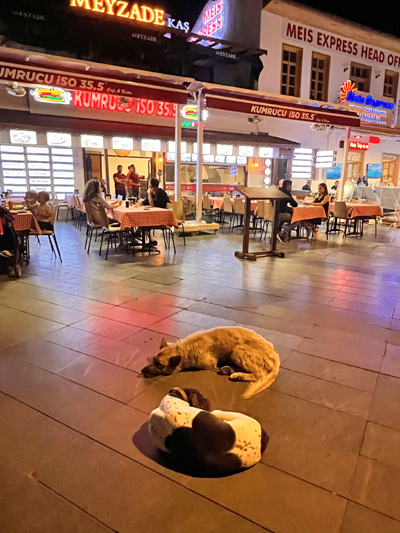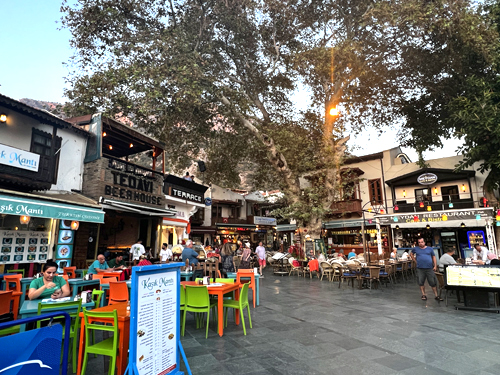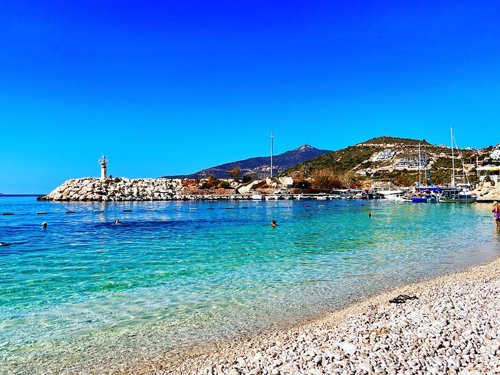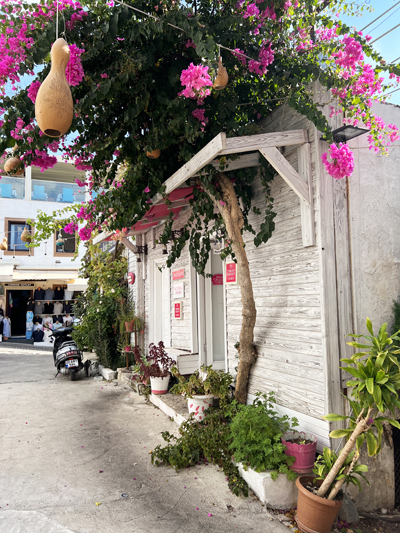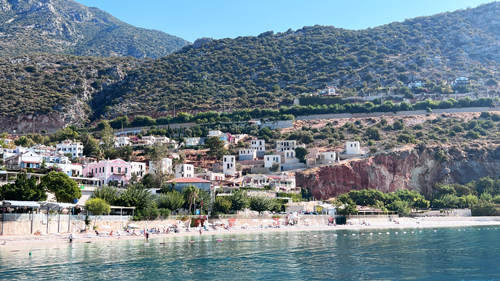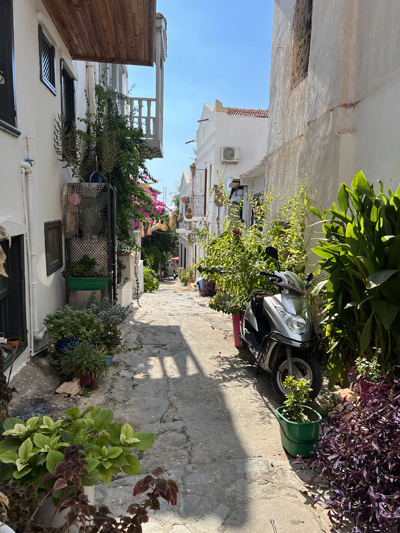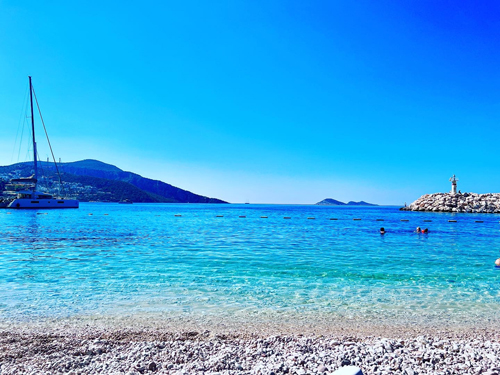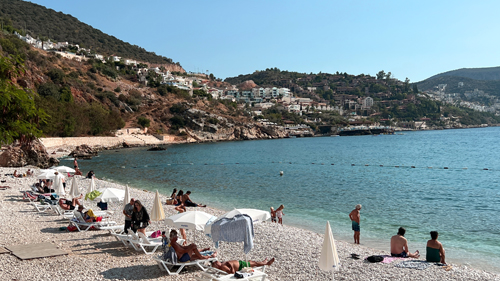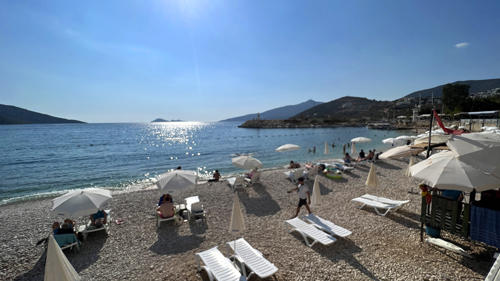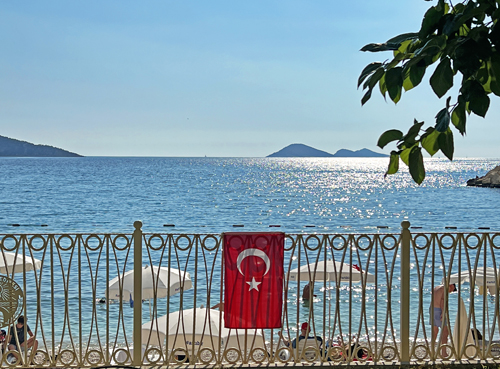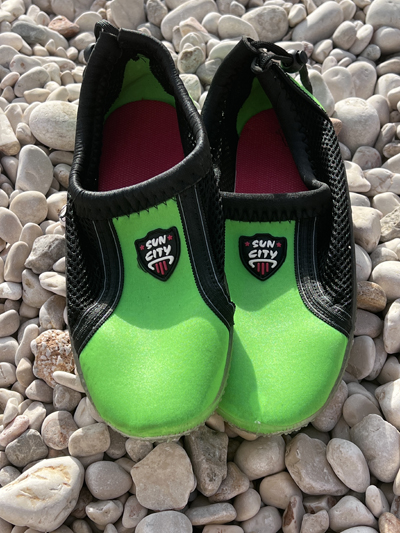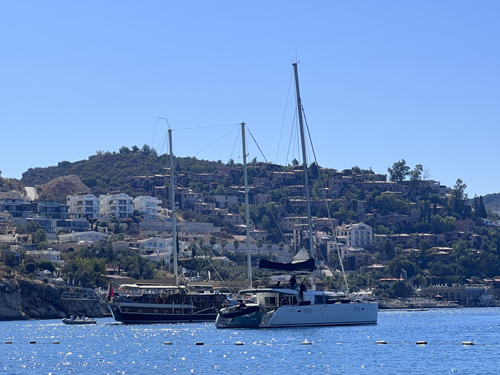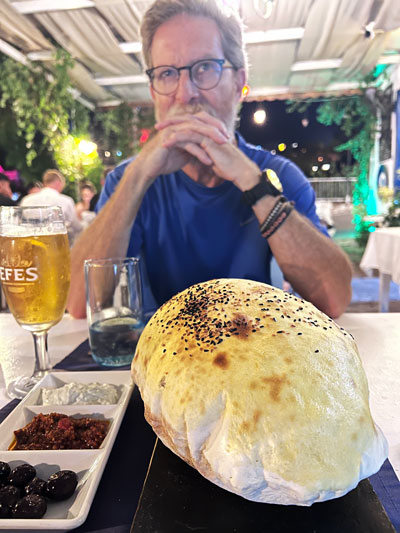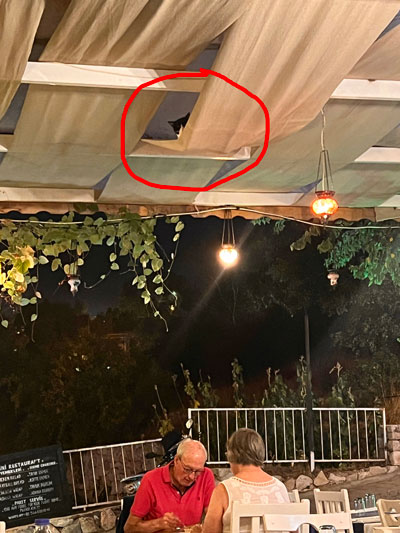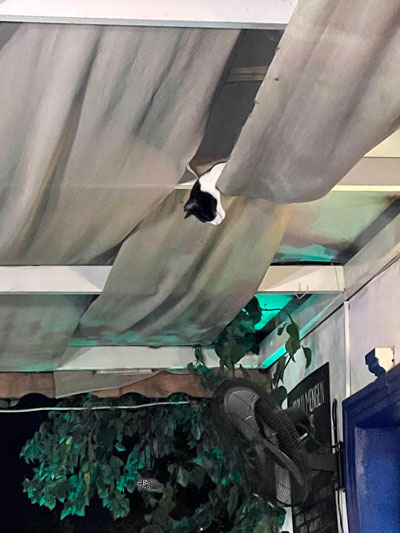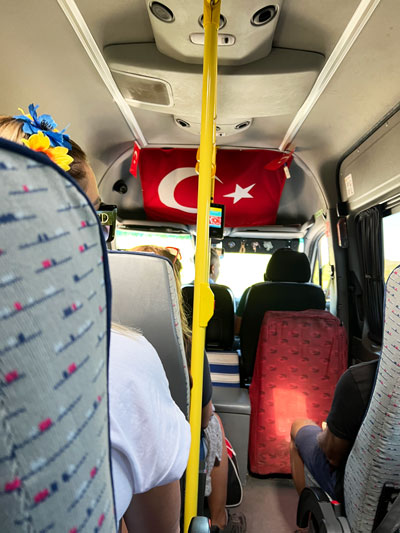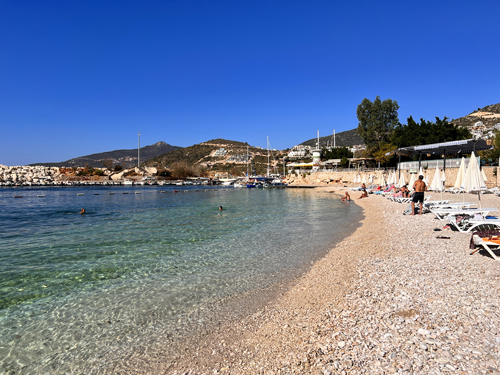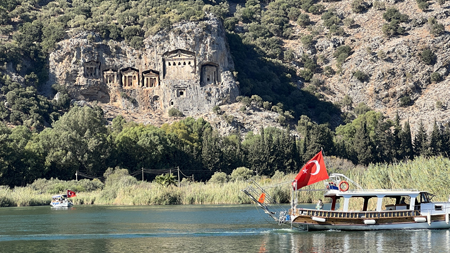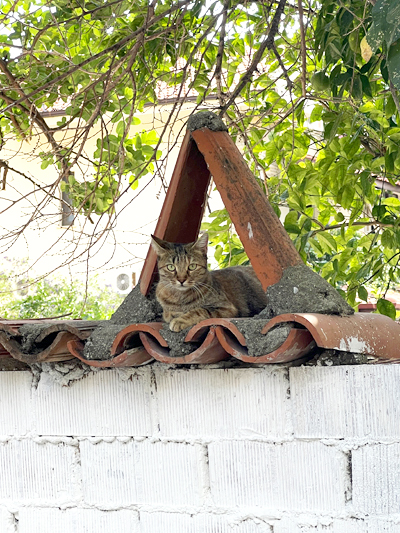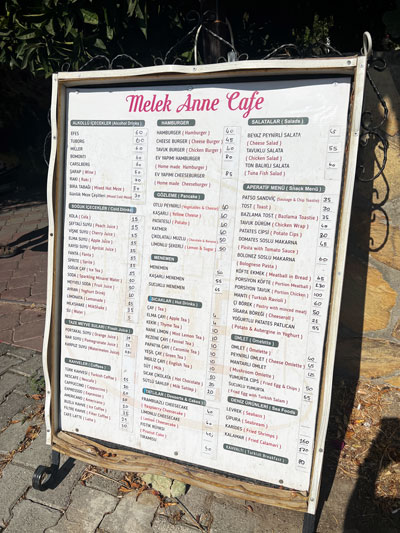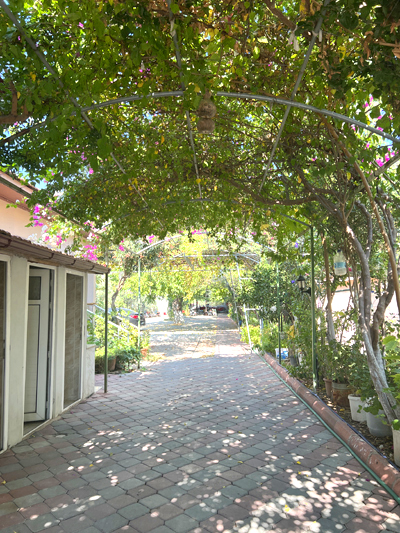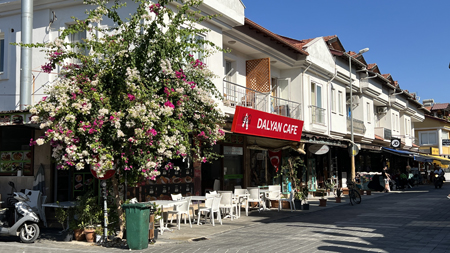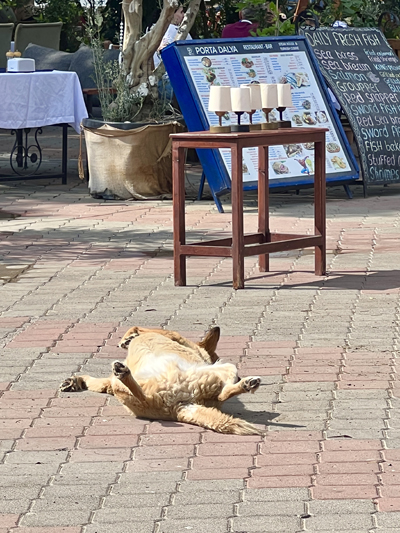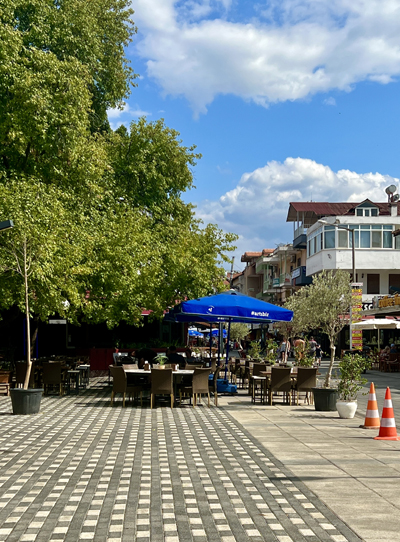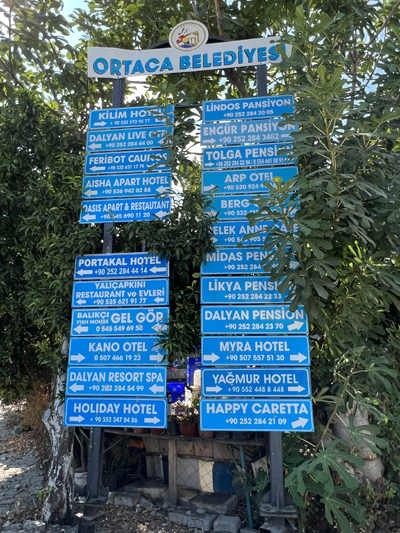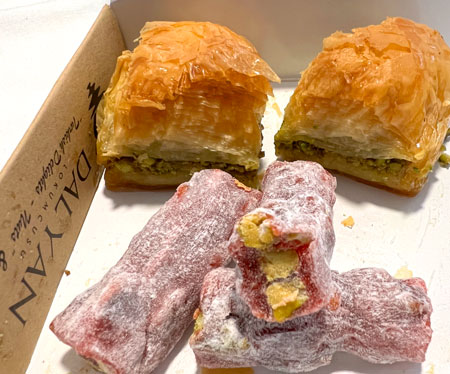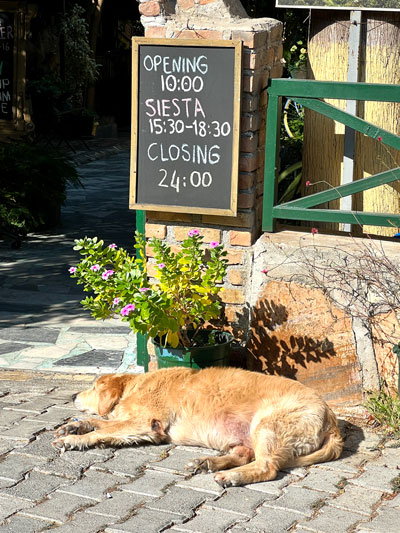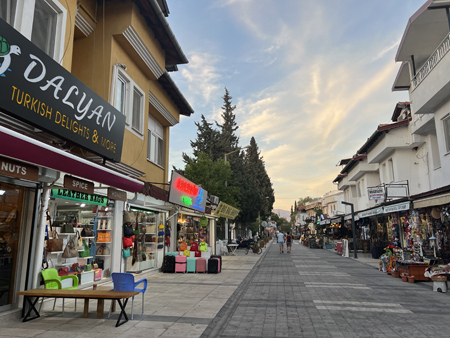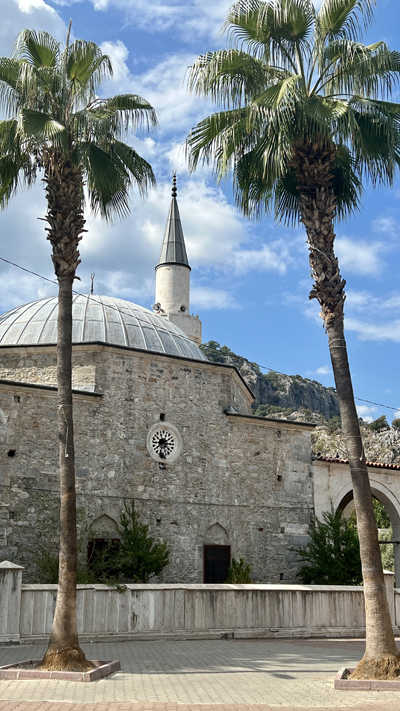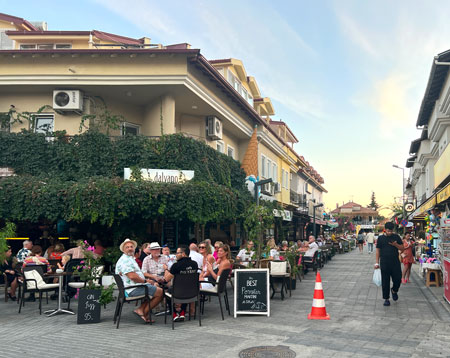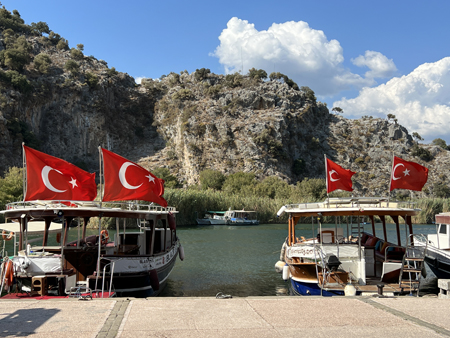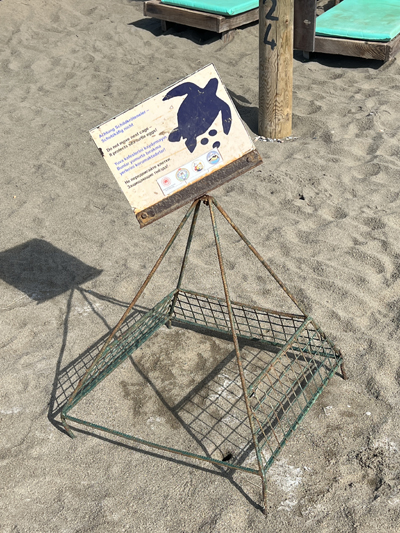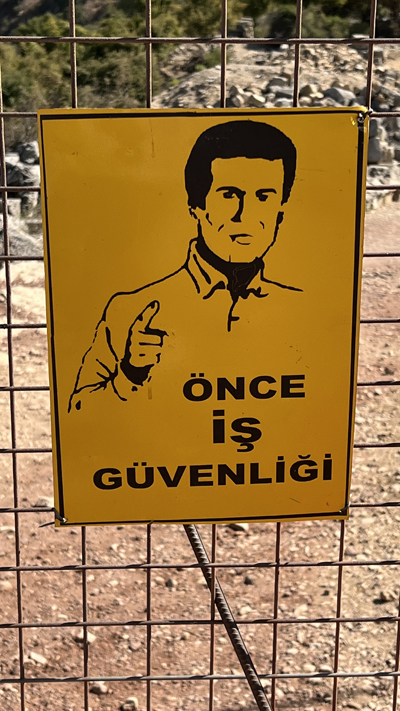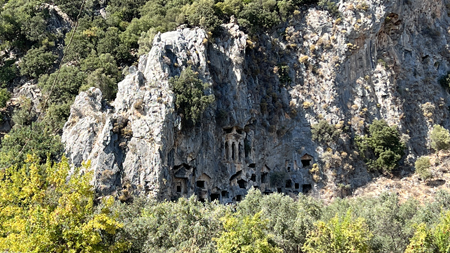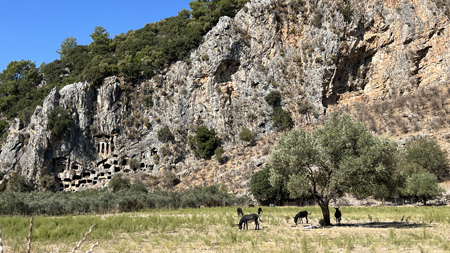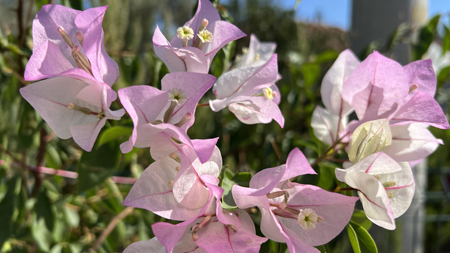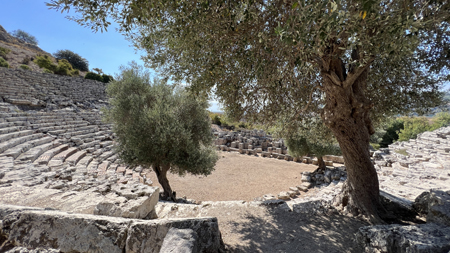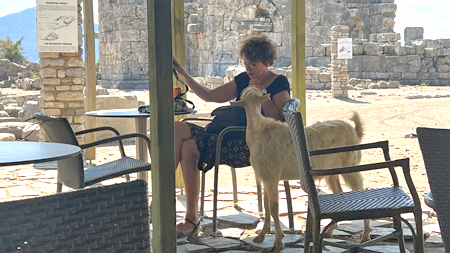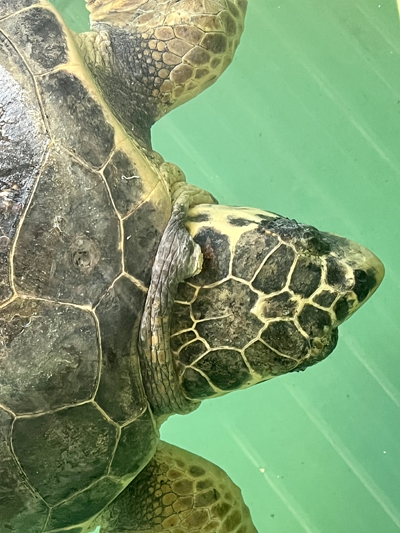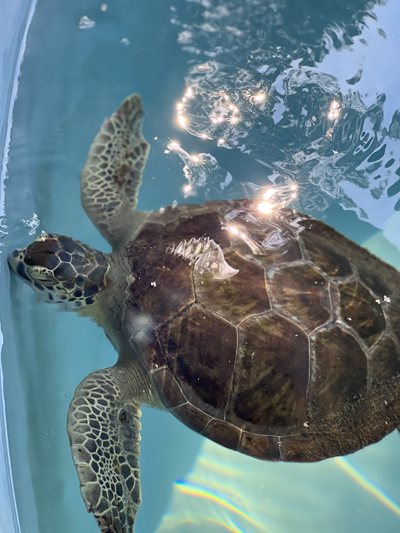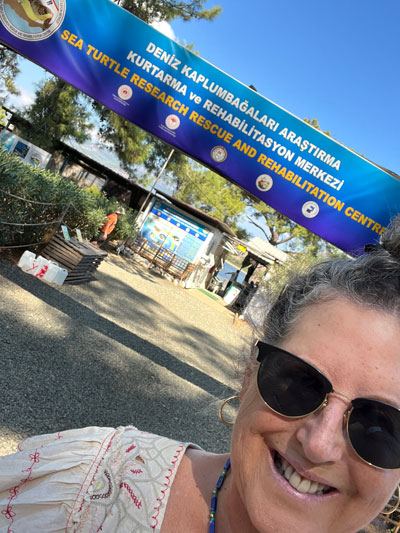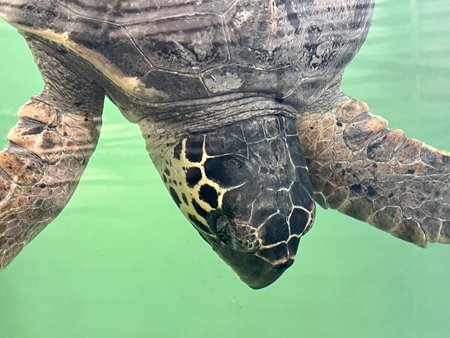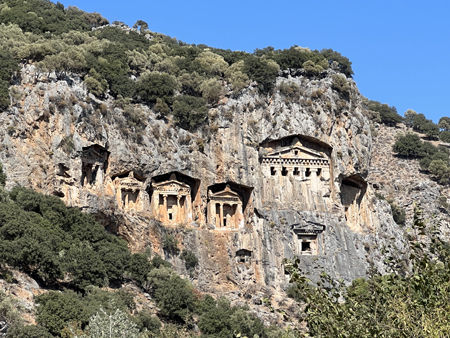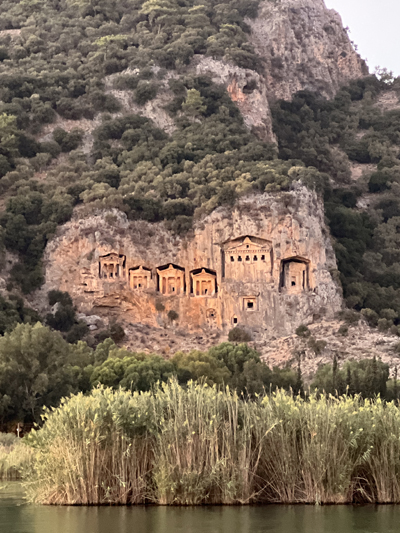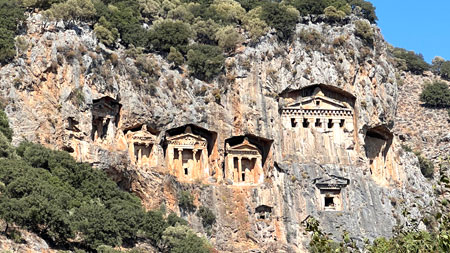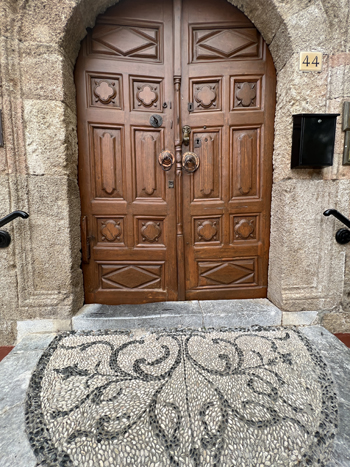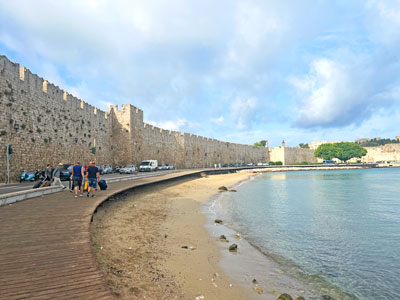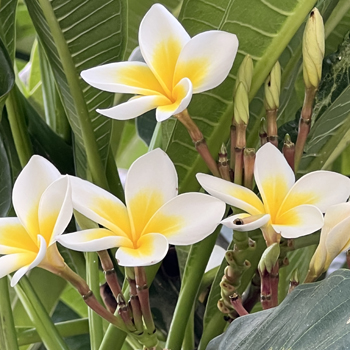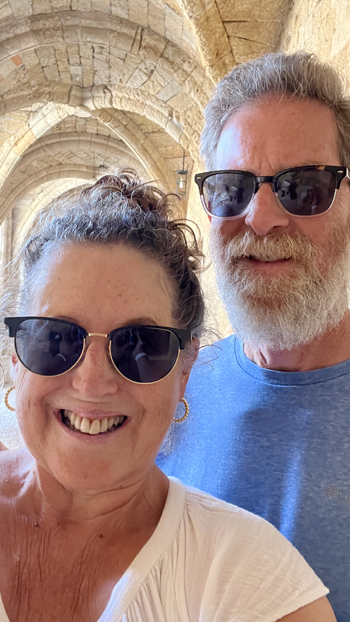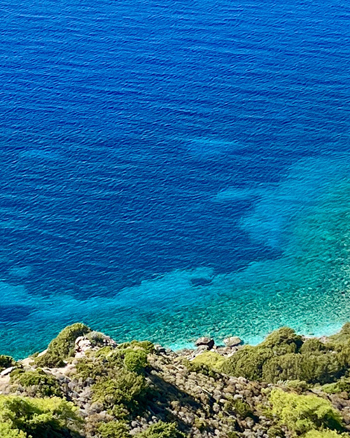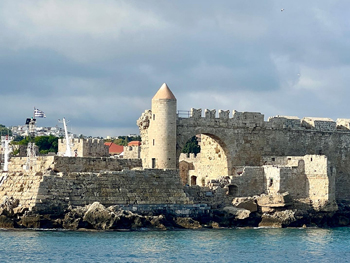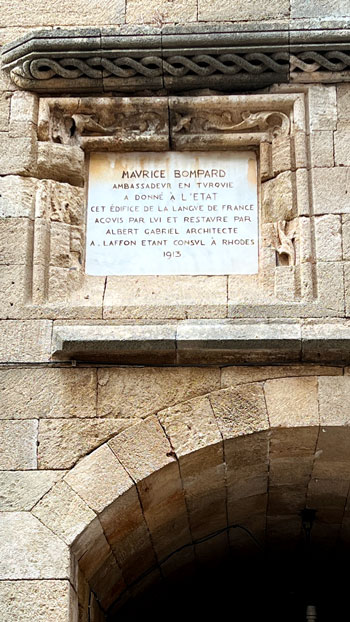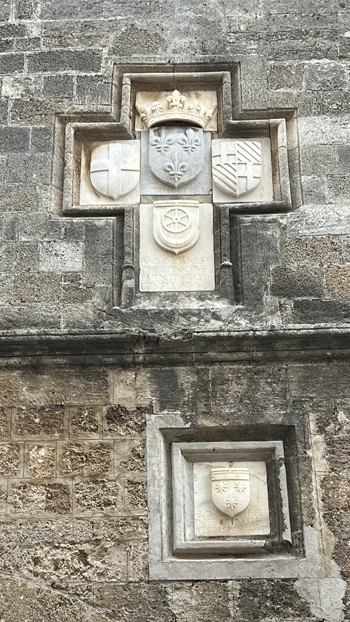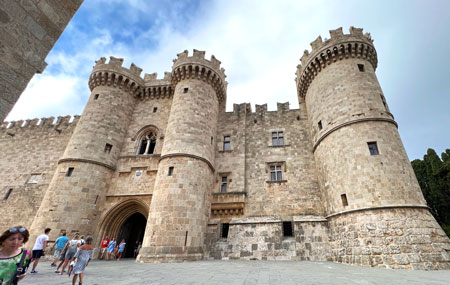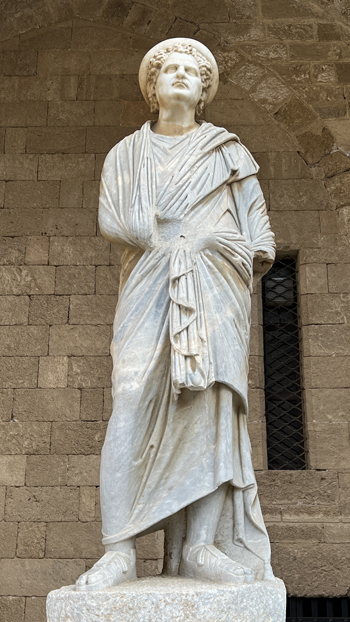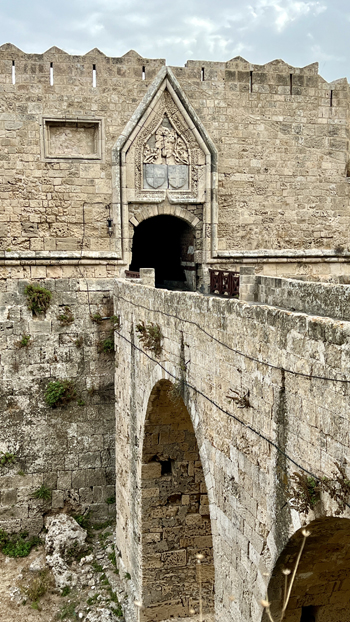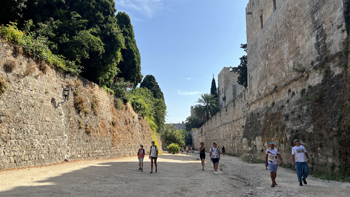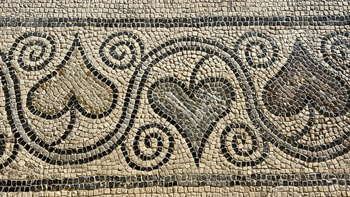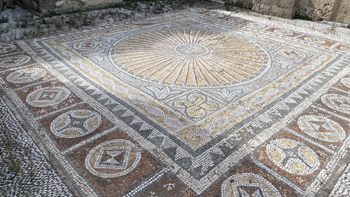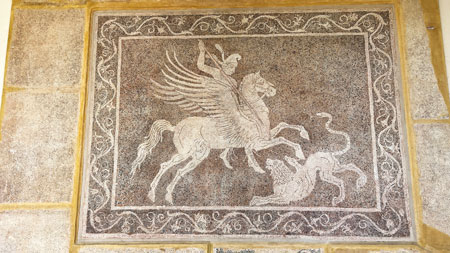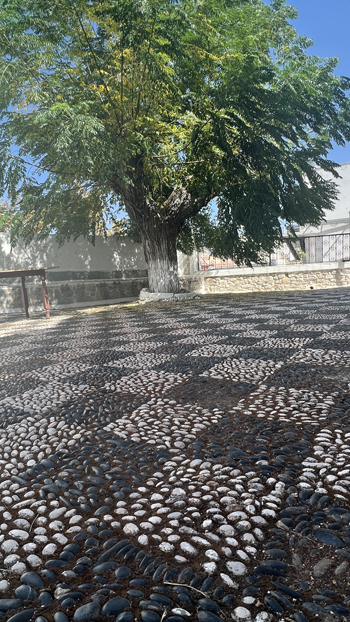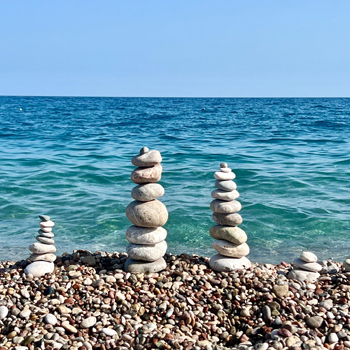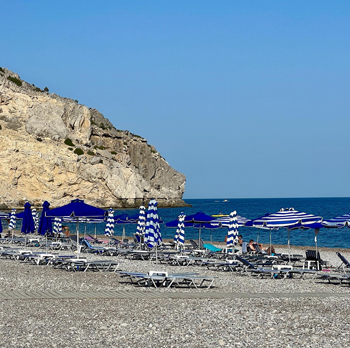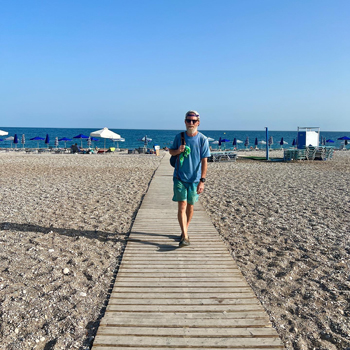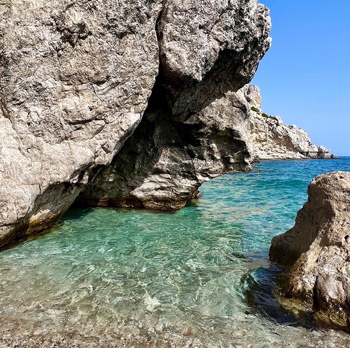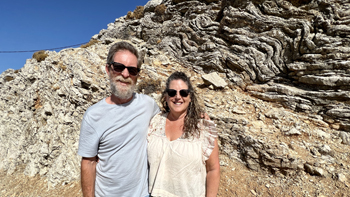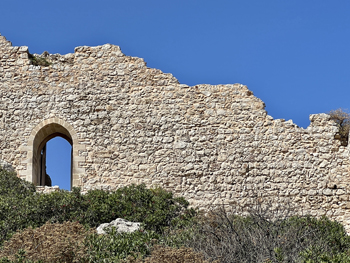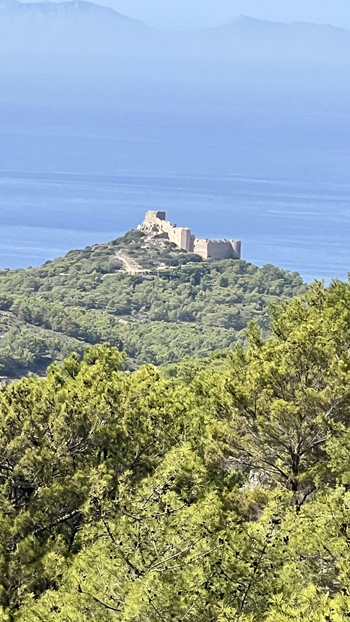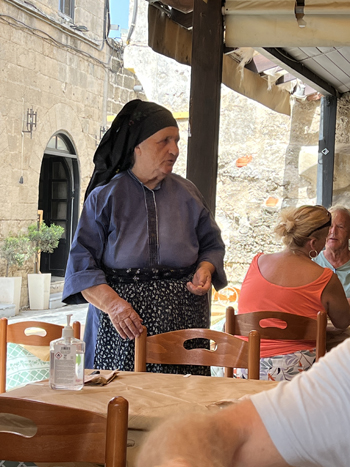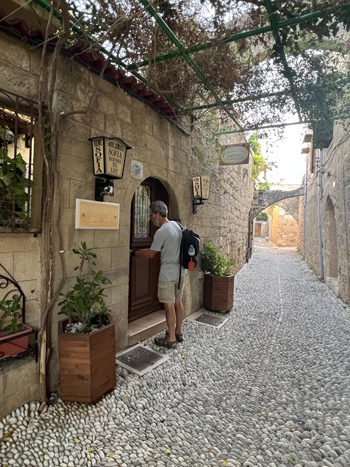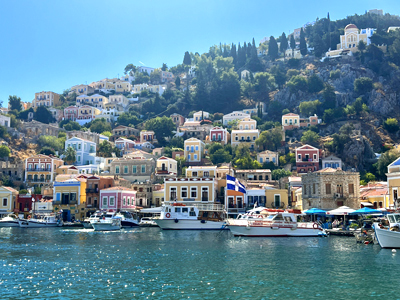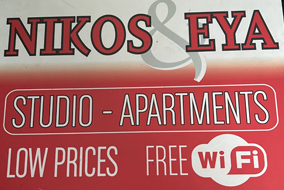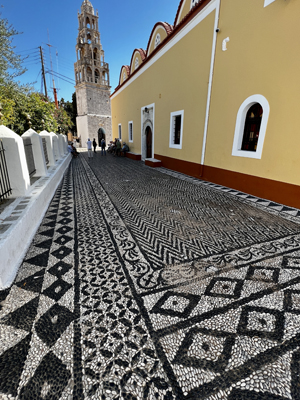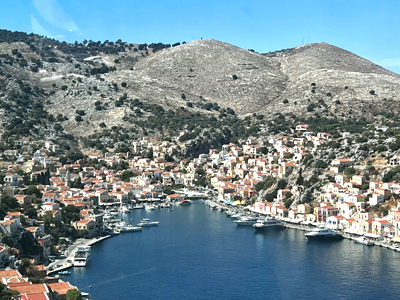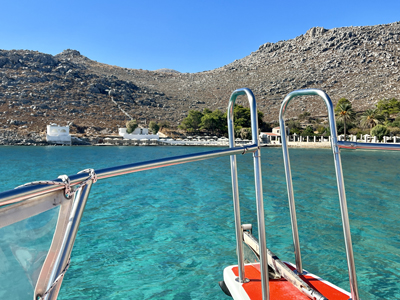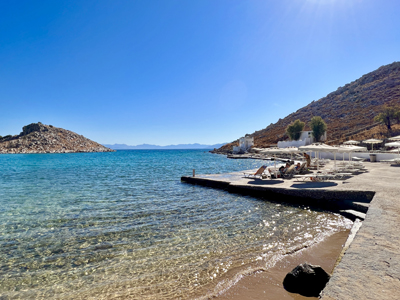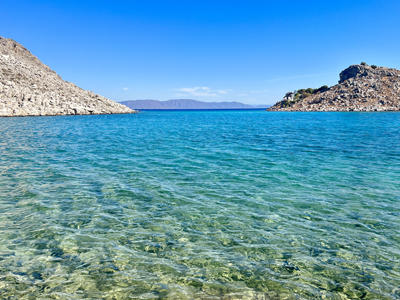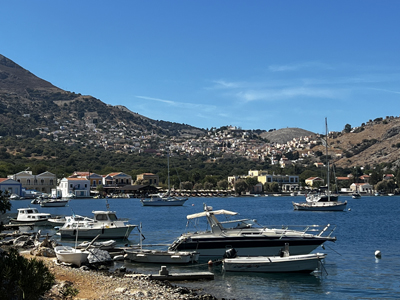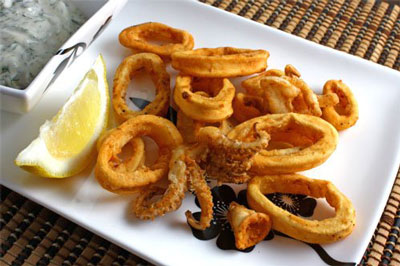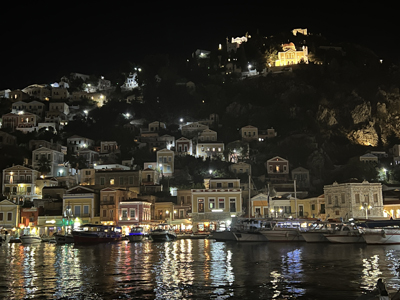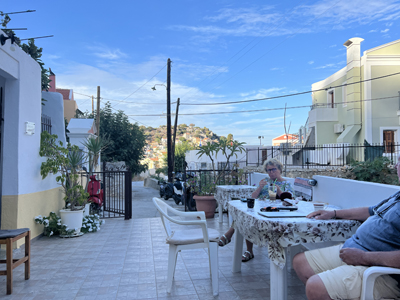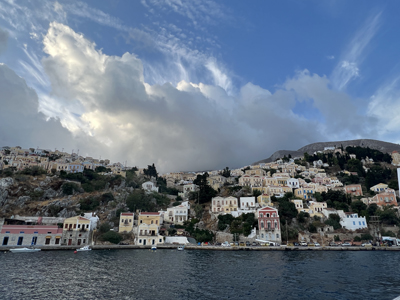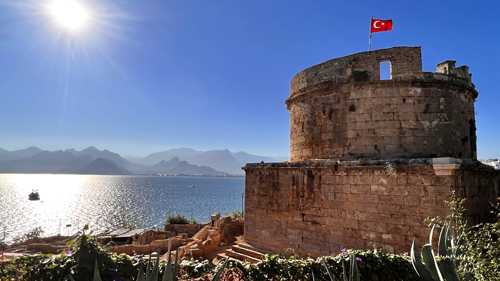
October 22 – 28, 2022
Last Stop on the Mediterranean
Antalya is a large and modern coastal city of 2.6 million people in southern Turkey. It’s a resort destination with stunning cliffside views of the Mediterranean and the Beydaglar Mountains.
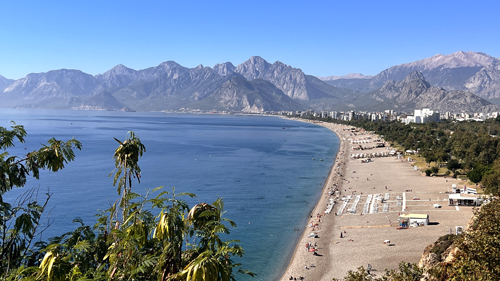
Antalya also boasts a long and wide pebble beach flanked by high rise hotels, shady palm-lined boulevards, and an ancient historic city center.
It’s our last stop on the Mediterranean coast, so we are relishing every moment.
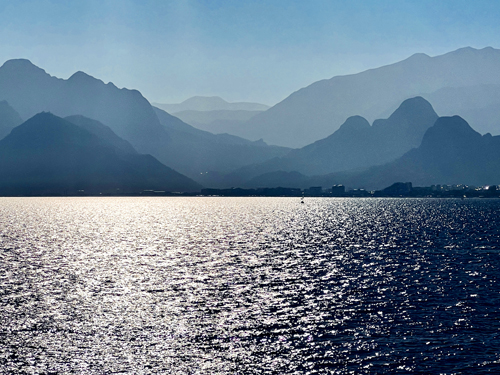
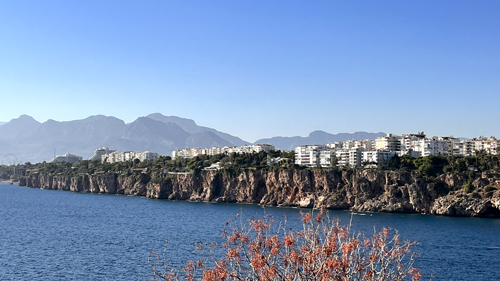

Kaleici
Everything I read on visiting Antalya advised us to stay in the old historic center of Kaleici, so that’s what we did. And it was the right choice for us. Kaleici is full of history and simply lovely.
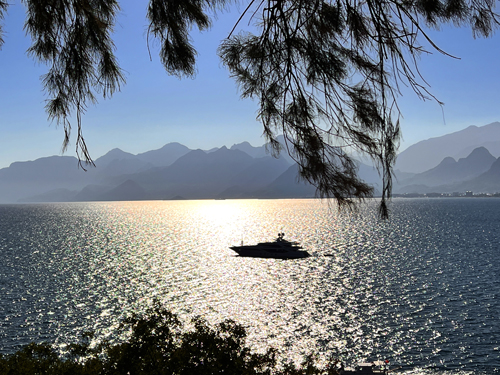
Kaleici is also full of cats, as is everywhere in Turkey. We passed the cat welcoming committee as we entered town.
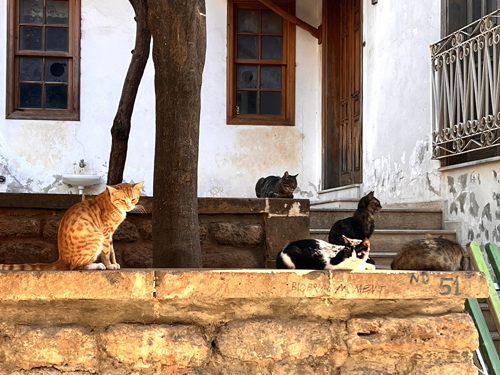
Our hotel, Sibel Pansiyon, is ideally located in the heart of everything old-town has to offer. We only had to walk out our door to find cute cafes, good restaurants, and charm galore. And the gorgeous sea is only a five minute walk away.
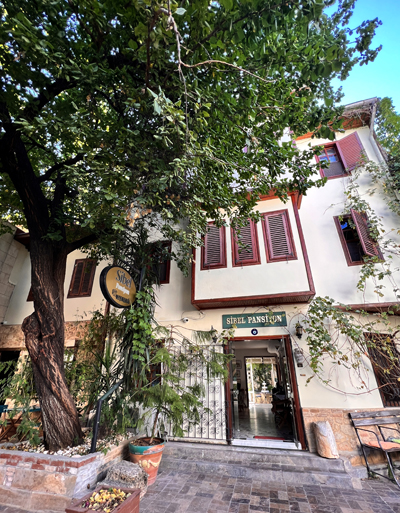
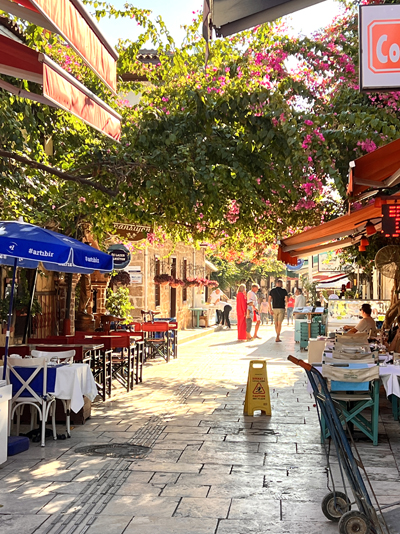
The Clean Streets
Kaleici’s streets are immaculate. The shopkeepers and restaurant workers keep the streets freshly swept or squeegeed at all times.
For all the cats and dogs, we’ve never seen a deposit, let alone stepped in one. Just clean, clean streets.

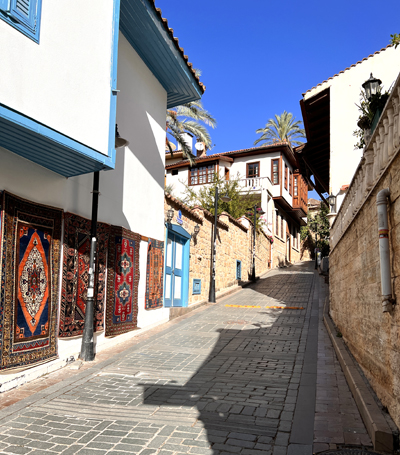
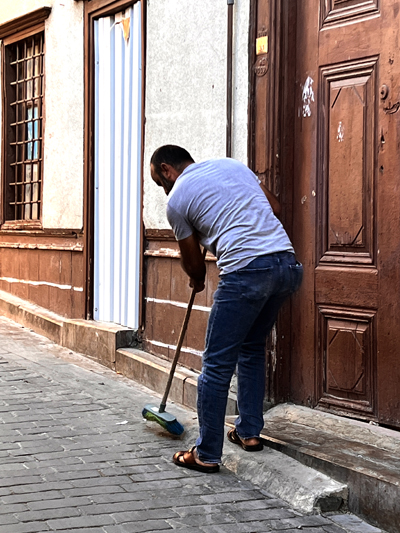
Saturday vs. Monday
Our first night in Kaleici was a Saturday night and it was hopping! There was a distinctly younger crowd in the streets, many dressed for the clubs.
The streets and restaurants were absolutely packed. We couldn’t believe the shoulder-season (late October) was still this busy.
Then came Monday (and Tuesday and Wednesday). What a difference a weekday makes. The crowds were cut in half. We assume many of the Saturday revealers were locals coming in to party.
Kaleici Style
We see countless examples of Ottoman style architecture, with the “pop out” porch. I love the old-world look of the stone buildings found everywhere, gorgeous carved wooden doors and shutters, and cobblestone lanes.
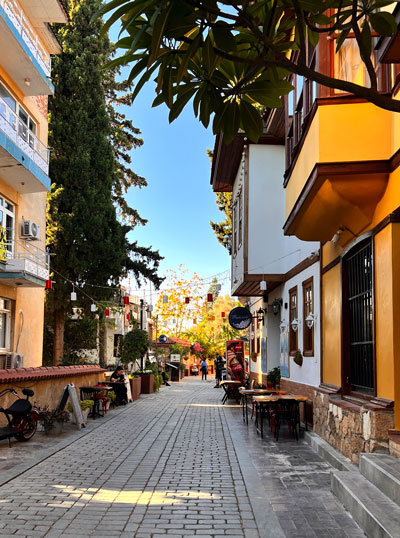
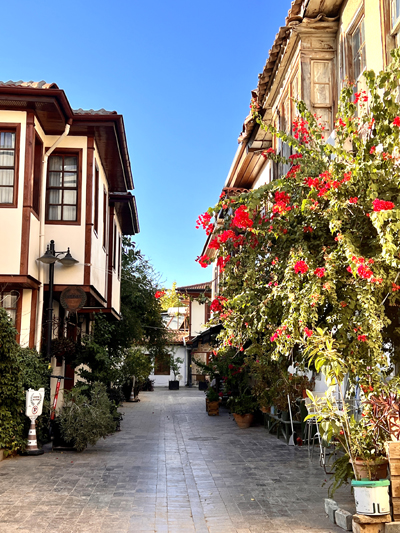
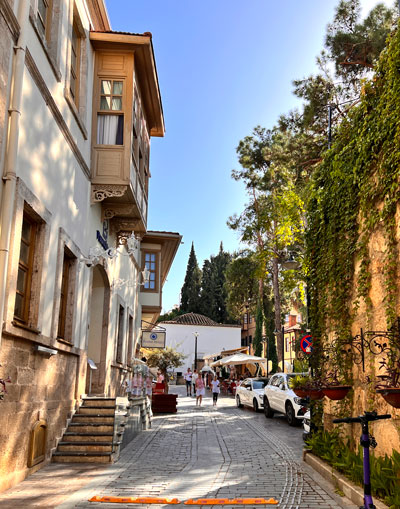
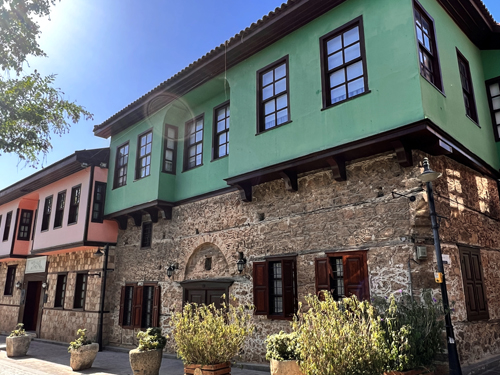
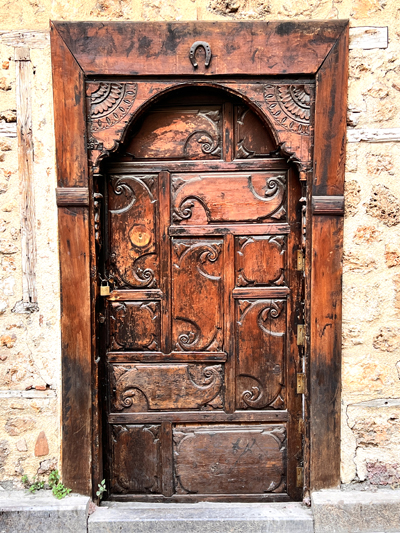
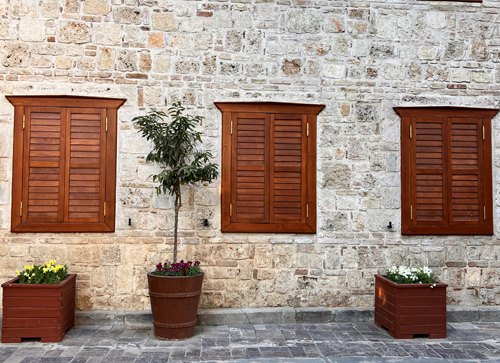

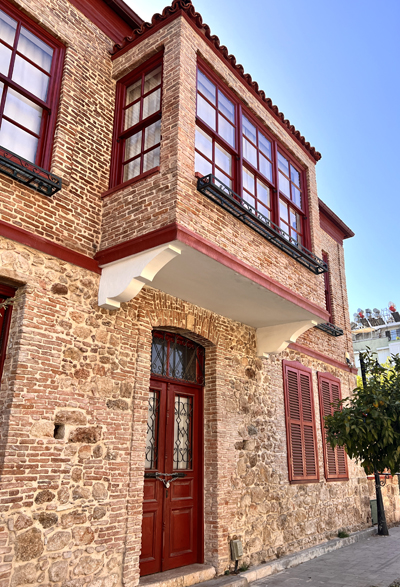
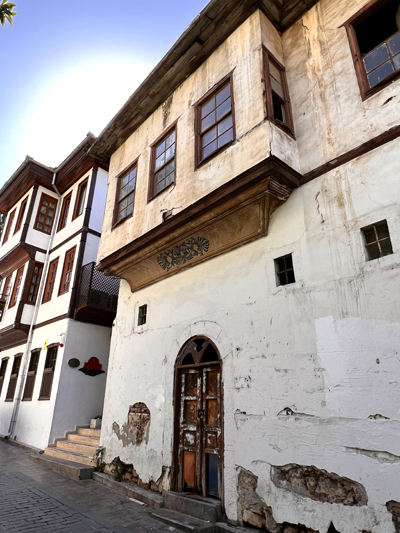
The whole of Kaleici is protected as a historic center which keeps it intact and a wonderful example of the past. The old town is immaculately clean. The flowers and plants are tended, there’s no garbage or trash thrown on the ground, and everything is neat and orderly.
The streets of Kaleici meander and wind. Around practically every corner is another picture-perfect sight of a curving lane full of flowers and vines, flanked by character-filled old buildings.
Pots Galore
Many streets are lined with potted plants, trees, and flowers. The planters are filled with impatiens, pansies, ferns, various trees, and daisies. I’ve never seen so many planters anywhere, outside of gardens.
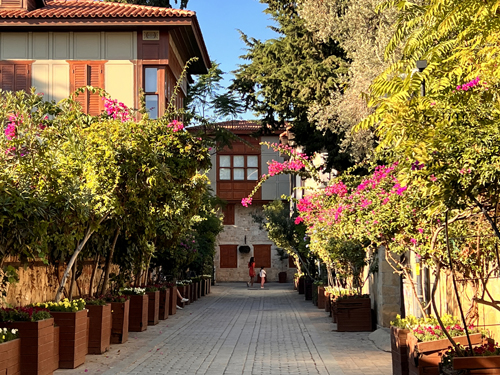
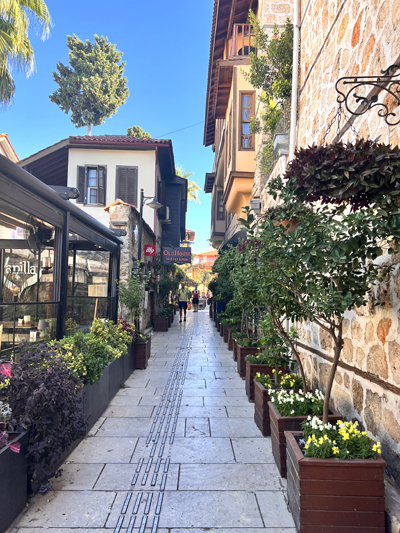
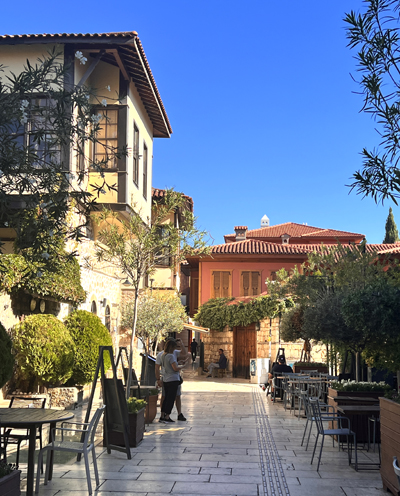
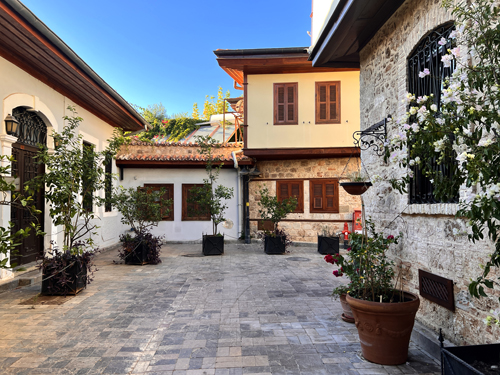
Here, the people create a garden along the street, adding greenery and pops of color, making each street exceptionally beautiful.
A Tight Squeeze

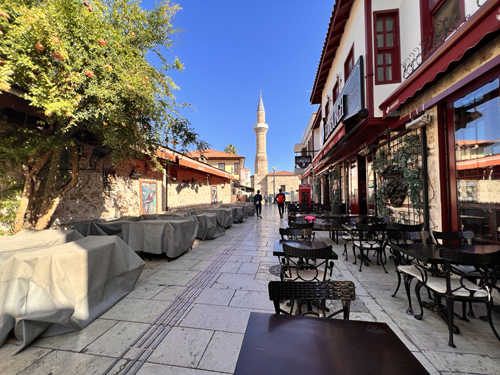
The streets are about as wide as a one-way street in the U.S. Still, they somehow manage to have seating two or three tables deep at the outdoor restaurants on both sides of the street, as well as pedestrians, dogs, and cats wandering every which way. Then they add in cars, bicycles, mopeds, and electric scooters!
It’s a tight squeeze, and I’m always amazed that no one and nothing seems to get hit, nudged, or scraped.
Hadrian’s Gate
Kaleiçi, until modern times, was almost entirely encircled by mammoth stone walls.
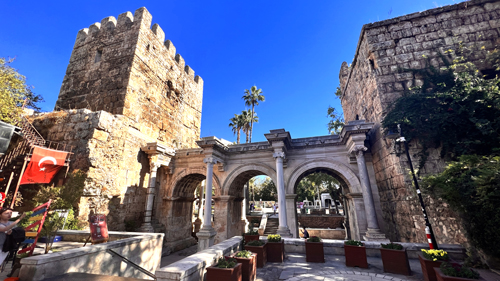
Hadrian’s Gate, located right on Atatürk Boulevard in Antalya’s city center, was once a part of the town walls, but now stands majestically alone. It’s the official entrance to old town Kaleici.
The imposing gate was built to commemorate the Roman Emperor Hadrian’s visit in 130 AD. At some point it was enclosed by the city walls, which is likely why it’s in such good condition.
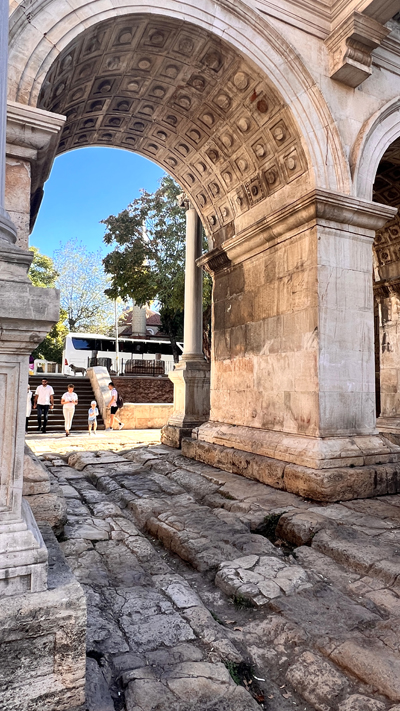
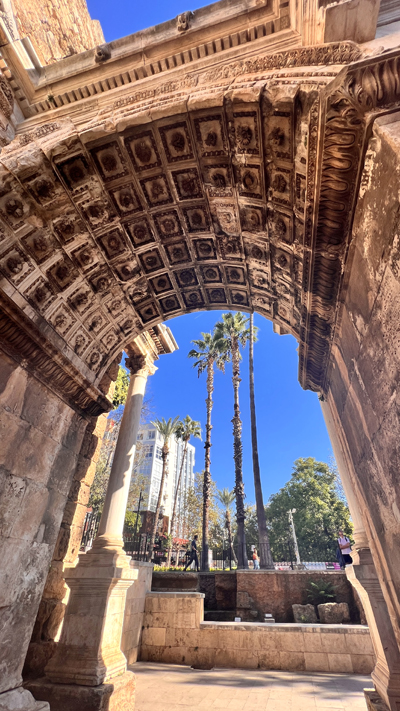
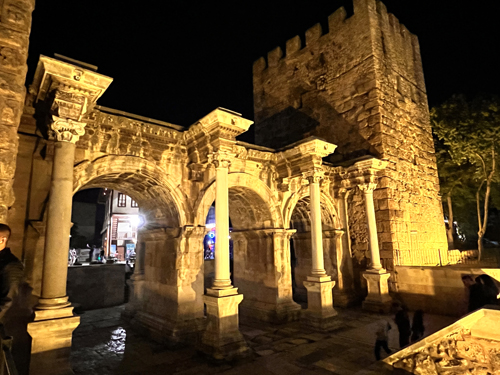
Perge Ancient Ruins
Perge (pronounced pear-ga), is a large site of ancient ruins about nine miles east of Antalya dating back to 4000-3000 BC.
Staying so close, just down the road in Antalya, we decided to take the tramvay (mass transit) out to the site, about a 40 minute ride. Antalya’s tram is clean, on-time, cheap, and very convenient. Our one way ticket was 9 lira, or .48 cents in USD.
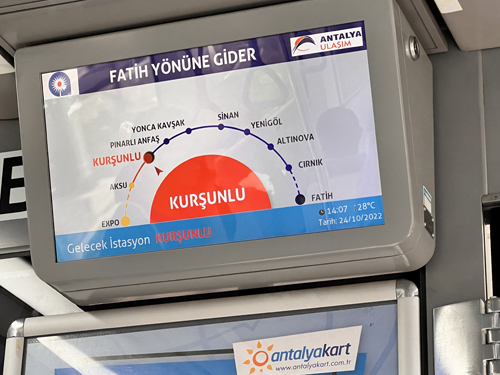
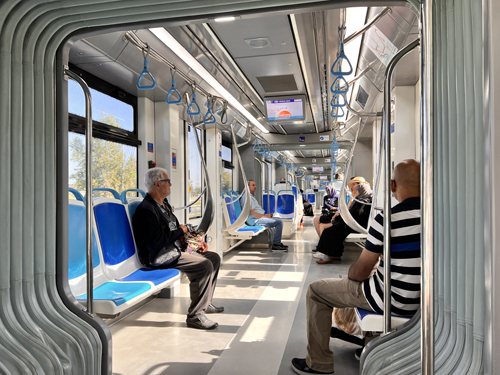
Perge Historical Notes
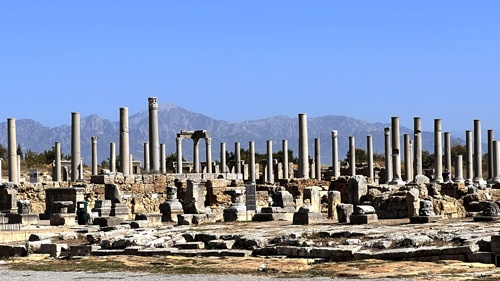
Perge is rich with history as Alexander the Great once strode through its gates, and the Apostle Paul preached there on his missionary journeys.
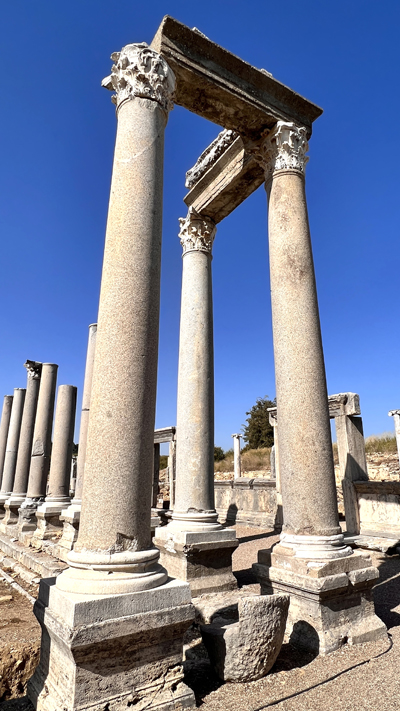
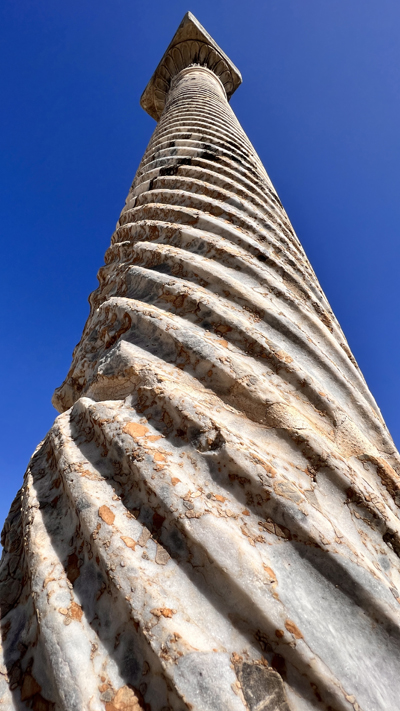
Perge was once an Ancient Greek, then Roman city. The Persians, Athenians, and Alexander the Great also had their time in charge.
The region was conquered by the Romans in 188 BC. Under the Romans, the town became a magnificent city with many impressive buildings. It is one of the oldest ancient cities in Turkey and one of the richest cities in ancient times.
The Median
In the middle of Perge’s Main Street into the city (from the Acropolis) the Romans constructed a long central water channel which contained a series of cascading pools. To us, it looked like a wide median often seen dividing a multi-lane highway back home.
Cascading pools lining the entire entry boulevard would have been quite impressive, to be sure. And the plumbing underneath transported water to the Roman Baths close by.
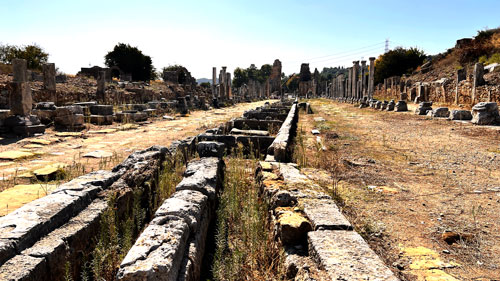
Chariots Of Old
It’s simply amazing to notice deep grooves in the stones where the constant passing of carts and chariots have left their permanent mark. Somehow seeing and touching the smooth grooves in the stone make it easier to picture the lives of the people living there so long ago.
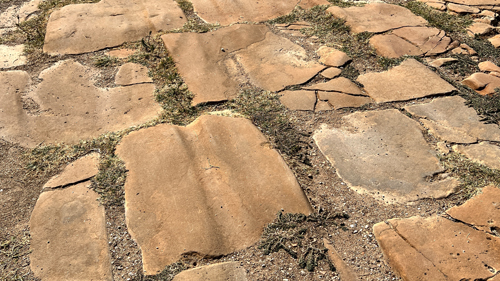
The Stadium
Perge boasts the second best-preserved ancient stadium located in Turkey. The stadium of Perge was built in the 2nd century AD.
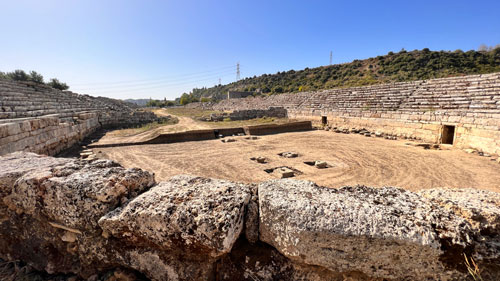
The stadium is huge. It is the length of two and a half American football fields. It’s 255 yards long, and 59 yards wide. It was one of the largest stadiums of its kind and could seat 12,000 spectators.
There is even evidence that an arena for gladiatorial combat was found at the northern side of the stadium. Now that’s pretty cool.
Perge Agora
An agora is an open space that serves as a meeting ground for various activities. It’s basically the town’s main square.
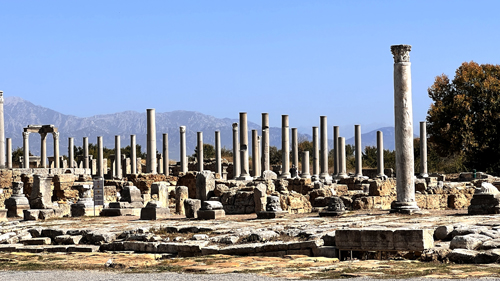
The Agora, built in the fourth century AD, is quite a sight to behold due to its size and the number of columns still standing (most of which have been reassembled).
This enormous square-shaped area measures 71 yards on each side. It was the second largest Agora in Turkey and consisted of three nested squares. The Agora was meticulously planned and a marvel.
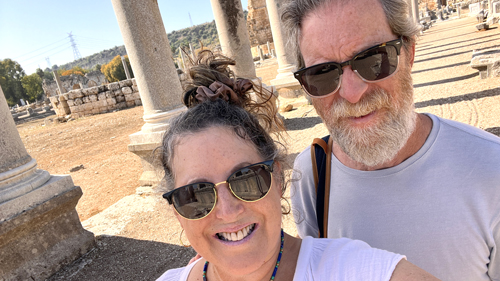
It was the center of the city, with a focus on shopping and political gatherings. Shops lined all four sides.
The circular structure in the center of the agora probably served as a fountain. Remains of plumbing are easy to see.
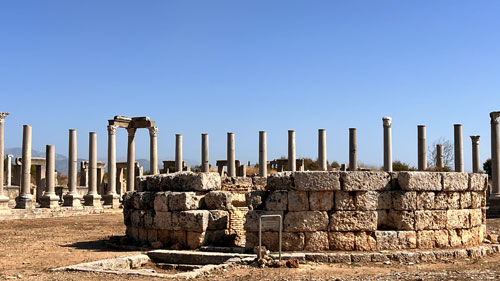
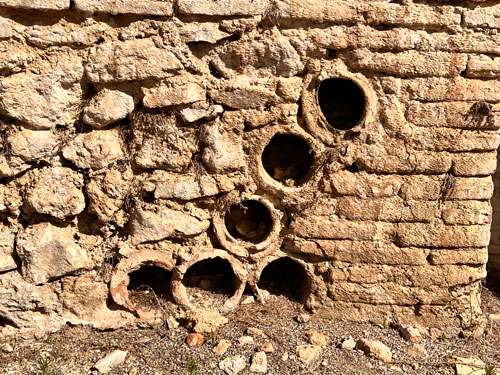
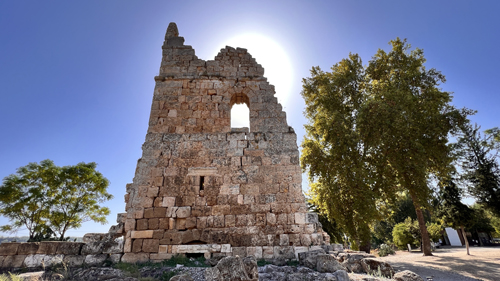
The Hellenistic Gate
It was fascinating to see the workmen standing high on the scaffolding, working on the reconstruction project at the Hellenistic Gate.



The original Hellenistic Gate towers date from the third century BC and were three stories high.
The Roman Gate
An impressive Roman gate sat just to the east of the Agora.
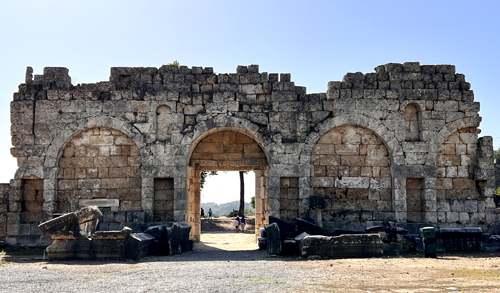
The Theatre
The ancient theater stands to the west of the city of Perge. The building combines Greek and Roman features. It was built in ~120 AD. The theater would seat up to 15,000 people.
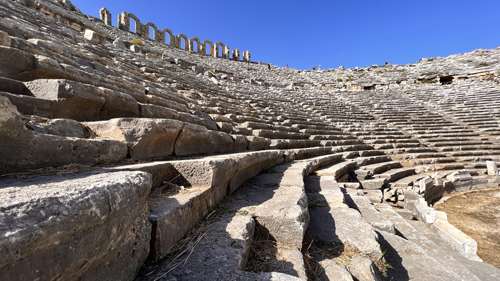
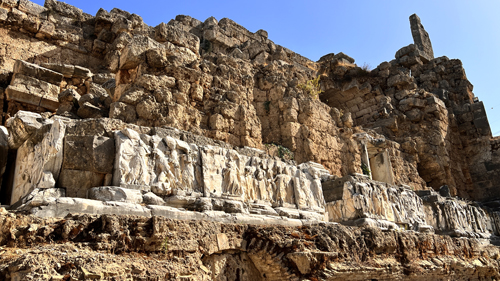
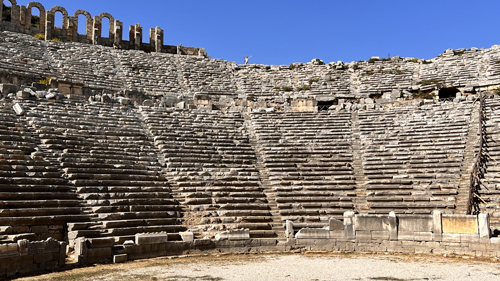
Reliefs depicting mythological scenes were displayed behind the theater.
The best reliefs are in the Antalya Archeological Museum, but we were still able to see some that remain in the theater.
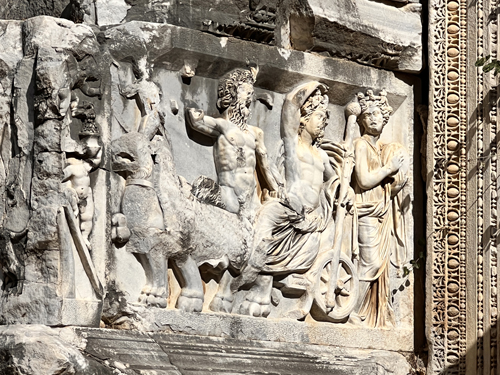
Antalya Archeological Museum
We spent our first full day in Antalya at the award winning, world-renowned, Antalya Archeological Museum. The museum gets a whopping 4.7 rating from 10k reviews on google, so you know it’s got something going on.
The museum’s 75,000 square feet is filled with artifacts and exhibits chronicling Anatolian history.
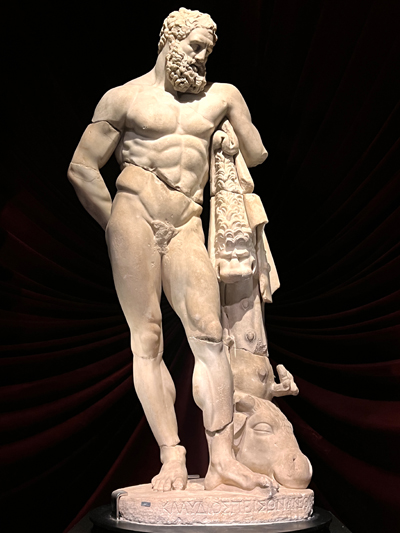
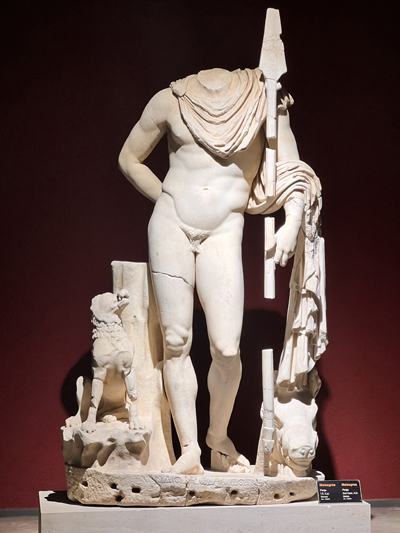
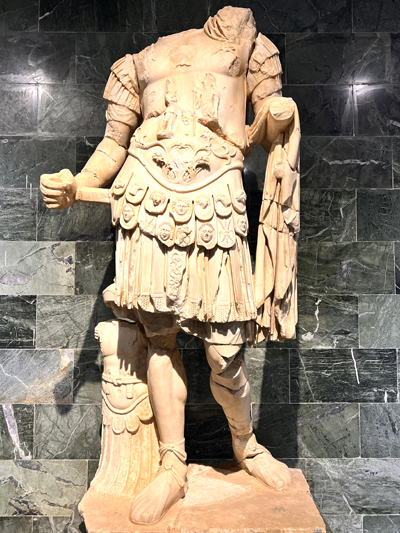
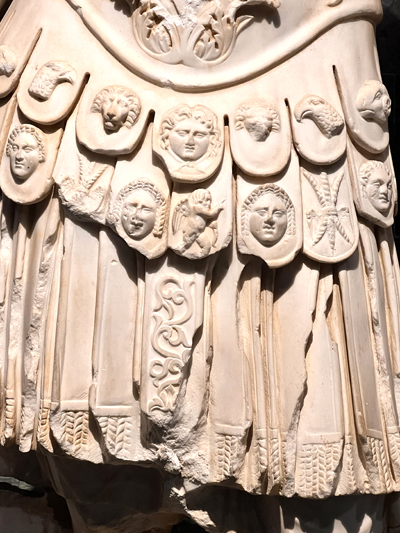
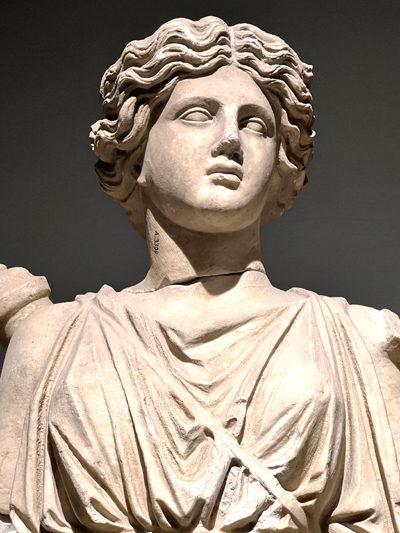
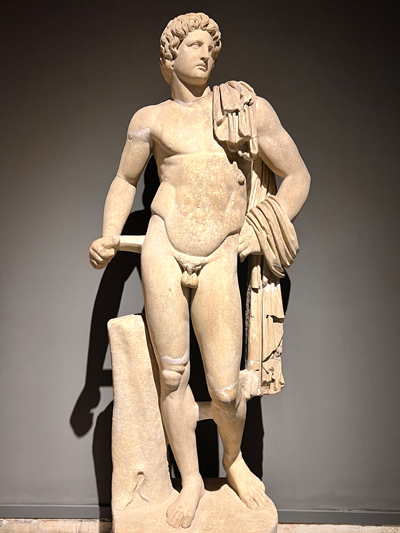
Marble Sarcophagi
I especially love the sarcophagi at the museum. Sarcophagi are coffins made of stone that are placed above ground.
The Perge sarcophagi were made in workshops by skilled artists in the second century AD, then exported to all corners of the Roman Empire, including Rome.
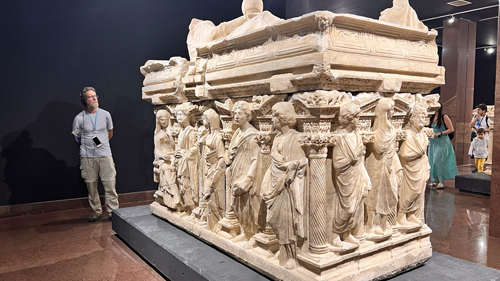
They are much larger than they look in photos. Most are 6 to 10 feet tall and 10 or more feet in length. The artistry is spectacular. The detailed marble carvings are beyond amazing.
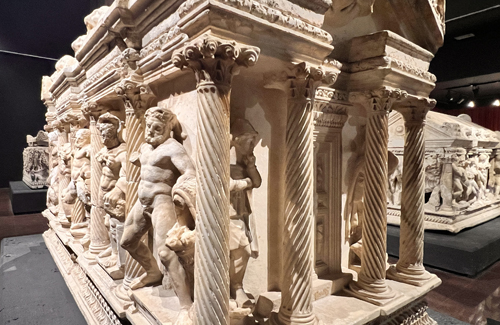
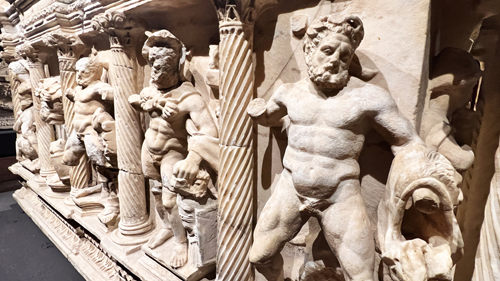
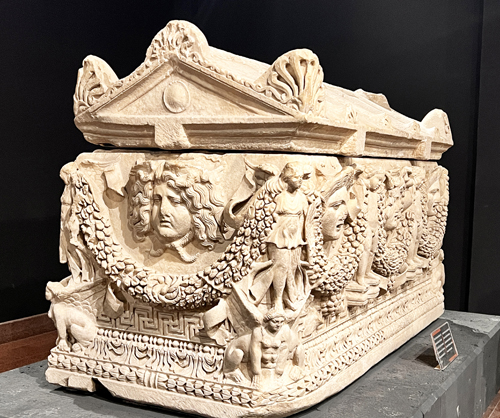
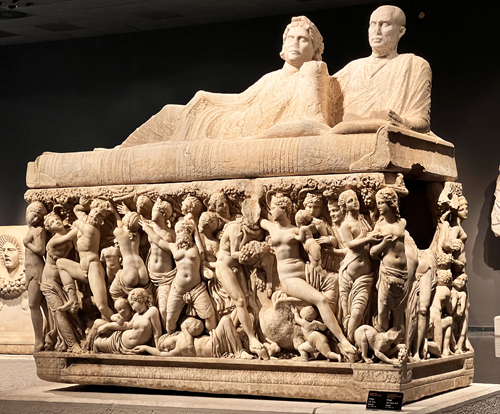
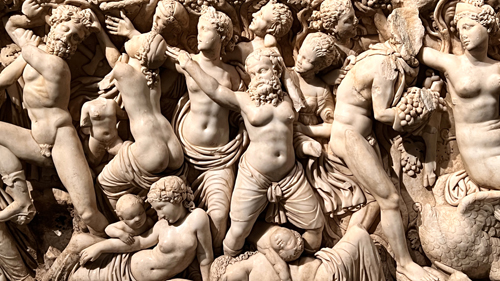
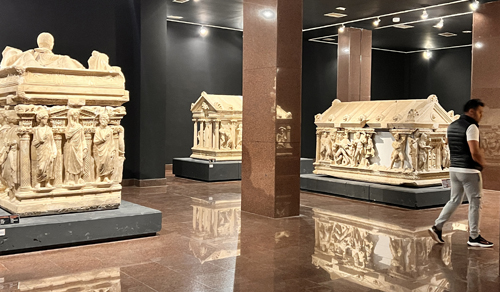
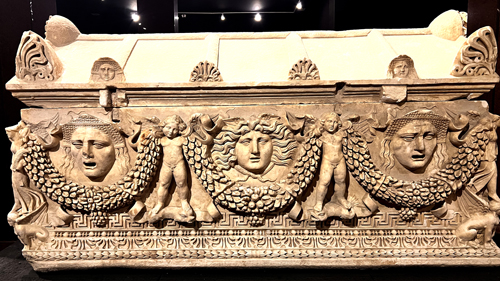
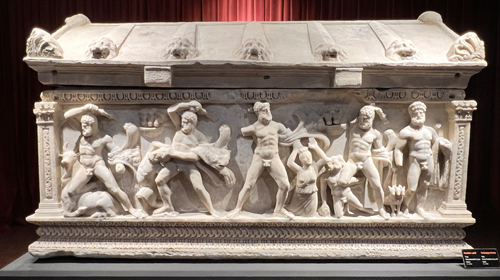
Adalar Beach
Unfortunately there are no real beaches, where the sea meets sand/pebbles, in the southwestern part of Antalya, near Kaleici.
There is a long and wide beach several miles away, but we’d need to take the tram or a taxi to get there, which is a hassle when you’re hot (and wet) after a day at the beach.
There’s a well known beach club, set on the rocks, Mermeri, that we checked out. It’s within walking distance. The location is beautiful, but the people were packed in like sardines. It didn’t look very appealing.
Luckily we found another beach club, Adalar Beach, similar to the one we went to in Kas. Set on the rocks with water access, it was perfect.
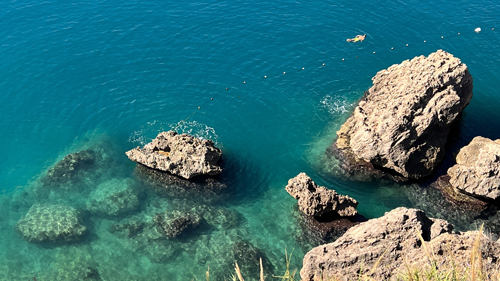
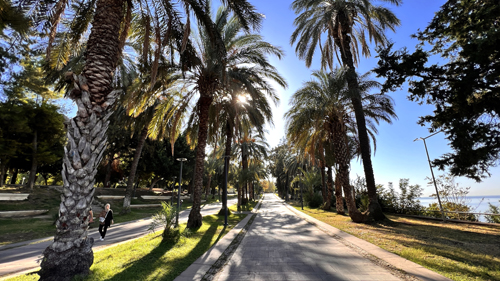

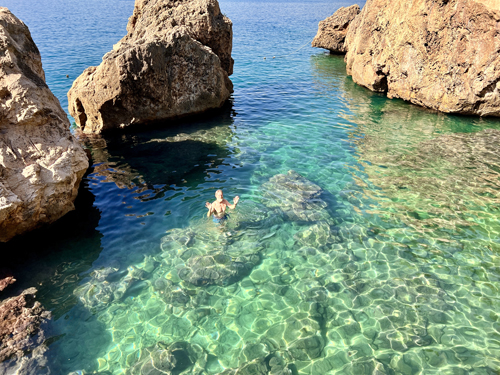
We arrived early, around 10 am, and had the place practically to ourselves for an hour or so. Even at the peak of the day, there were open sunbeds. It’s likely because it’s late October, the end of the summer season.
The water was crystal clear and practically glowing. It was in the high 70’s. We could easily see small schools with hundreds of fish just below the surface. To enter the water we had to climb down a long ladder into the immediately deep sea.
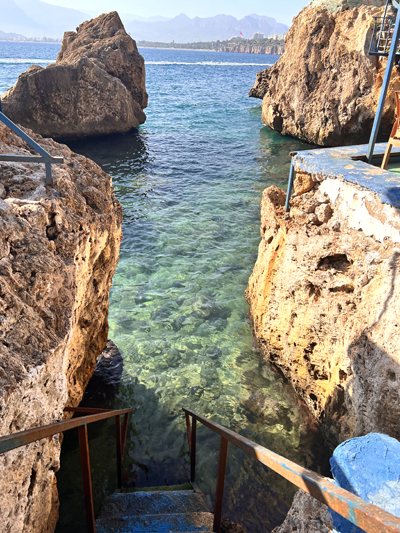
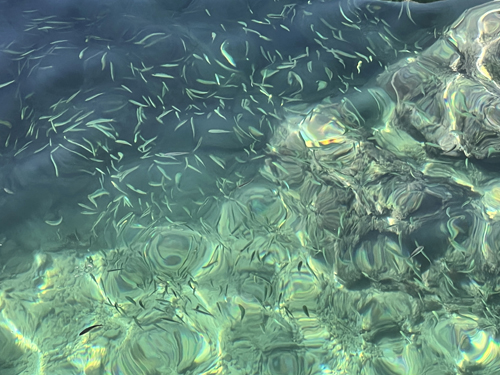
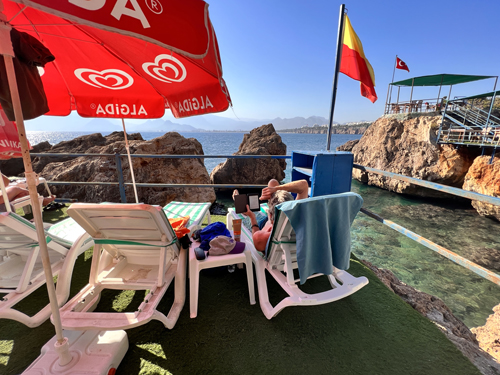
Going Coastal
Antalya has numerous sprawling parks all along the waterfront, both in Kaleici and outside of Kaleici. Most have colorful flowerbeds, fountains, gigantic statues, and tons of seating looking out to the sea and mountains.
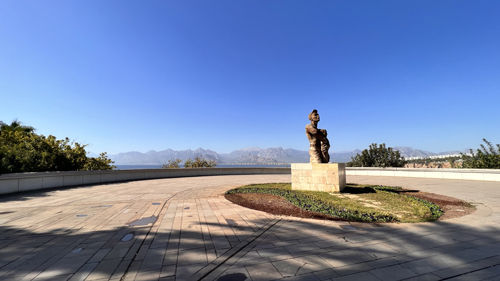
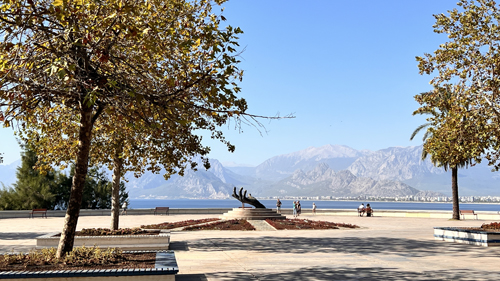
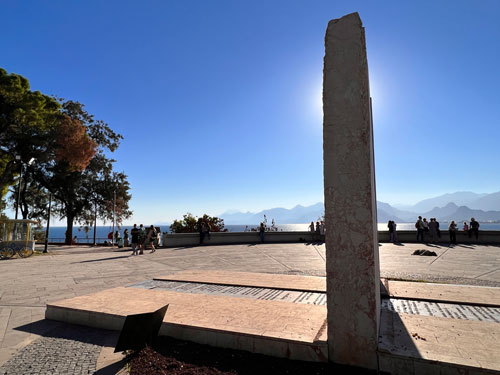
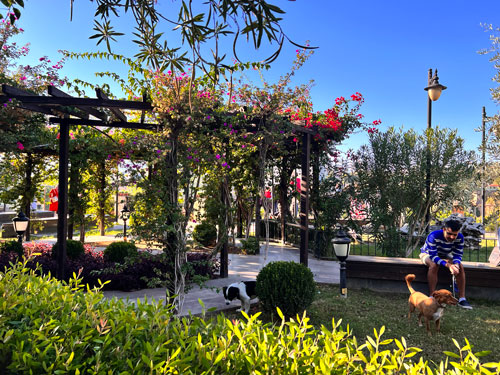
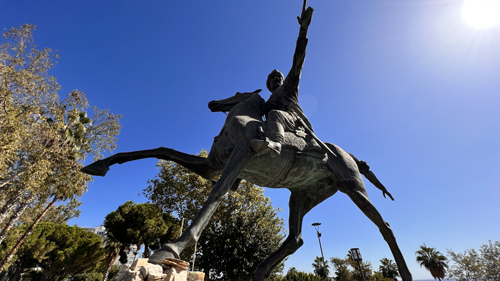

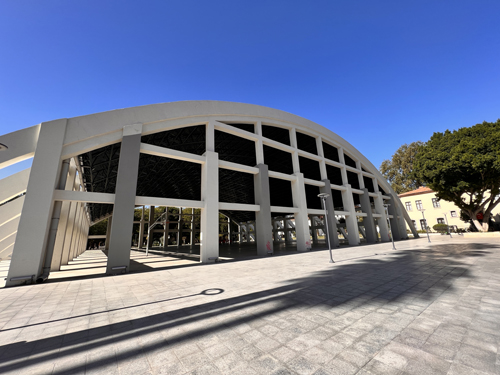
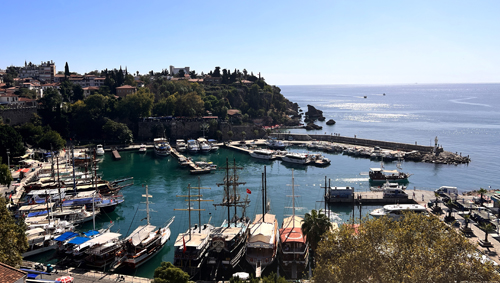
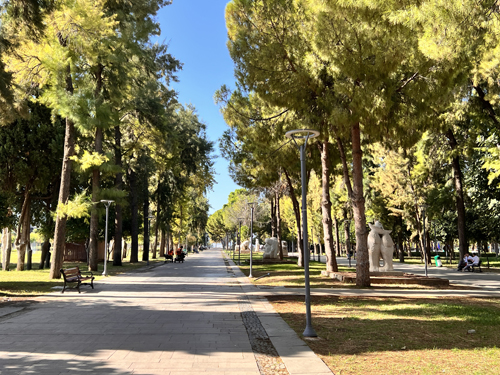

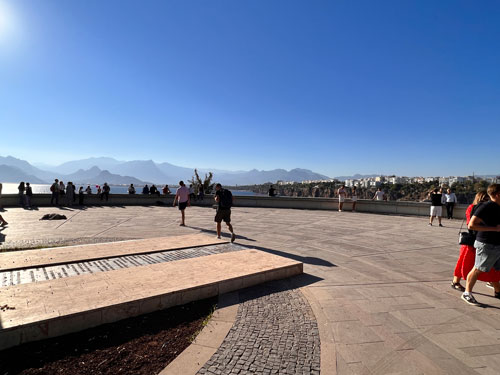

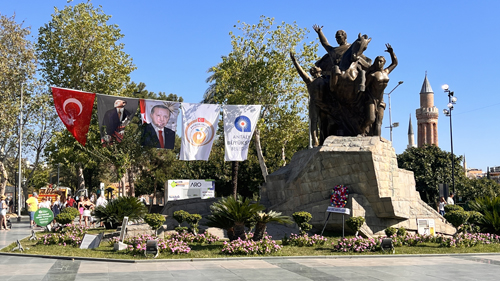
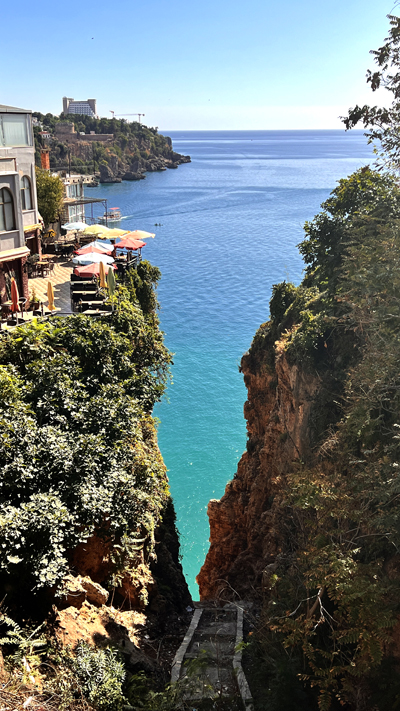

Wins & Losses
Trying French
After eating, or when exiting a restaurant, the owner or server consistently says, “Bon Appetit!”.
This just cracks us up. But we do acknowledge that we likely butcher plenty of Turkish phrases ourselves.
Downwind
You cannot use spray sunscreen when you are at a breezy beach club and people are in sunbeds just downwind from you.
Nope, it doesn’t work. Stop doing that.
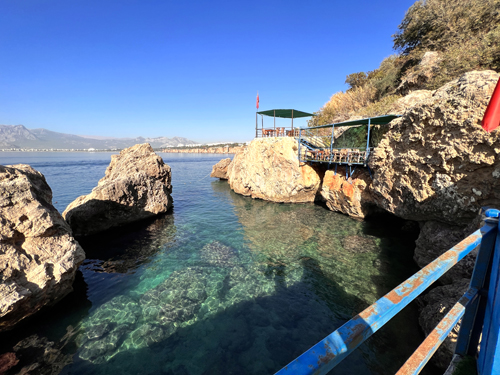
Late October
Turns out that late October hits the sweet spot here on the southern Turkish coast. Not too hot, not too cold. It’s still plenty warm to swim and sun (high 70’s into low 80’s), but not so hot that we’re a sweaty mess all day. Yep, perfect.
The Bride
A beautiful bride was posing near Hadrian’s Gate. Stunning.
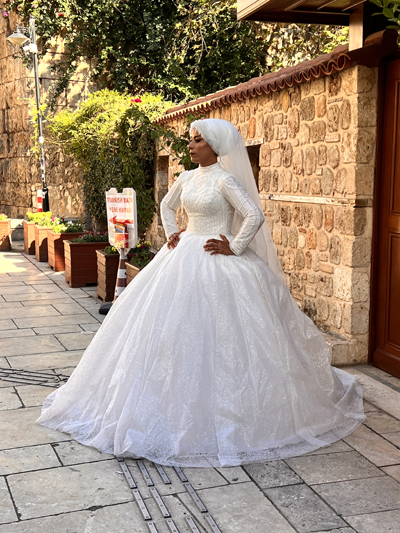
Gravity
Was fun to watch the movie Gravity, with Sandra Bullock and George Clooney, dubbed in Russian, from our hotel room. It certainly helped that we’ve seen it before and it doesn’t have much dialogue.
Sandra Bullock freaking out in a rocket in English or Russian sounds pretty similar anyway.
Cats
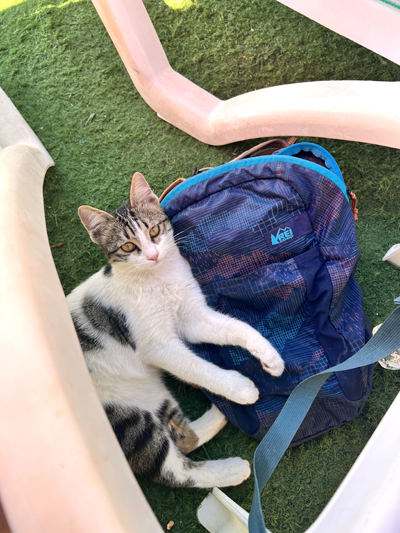
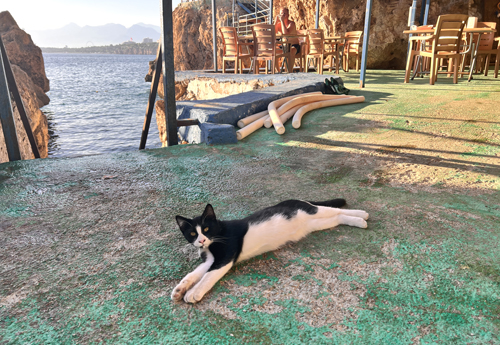
I had a beautiful cat under my sunbed most of the day while at Adagar Beach. Now and again it would roll over and onto our REI backpack, just to say hello.
Then I got to say hi to his buddy on the way out. Win!
The Dog
While walking in Kaleici, a beautiful, large, brown eyed dog adopted me.
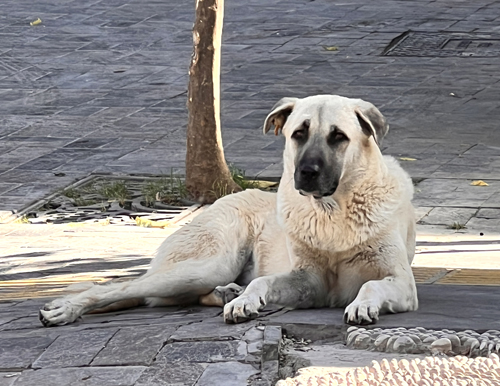
He was so sweet looking (like my Bailey at home). I couldn’t help myself, and I sweet-talked him a bit as we walked by.
Well, I guess that was enough for him, and he started following me. We were walking at a slow pace because it was the end of a long day, and we were on a never-ending steep hill.
I’d stop to catch my breath and my dog would stop and lie down by my feet, casual as could be. Like we’d known each other for eons. I’d slow my pace, and my dog would slow too.
He’s the best trained dog I never trained. 😂
